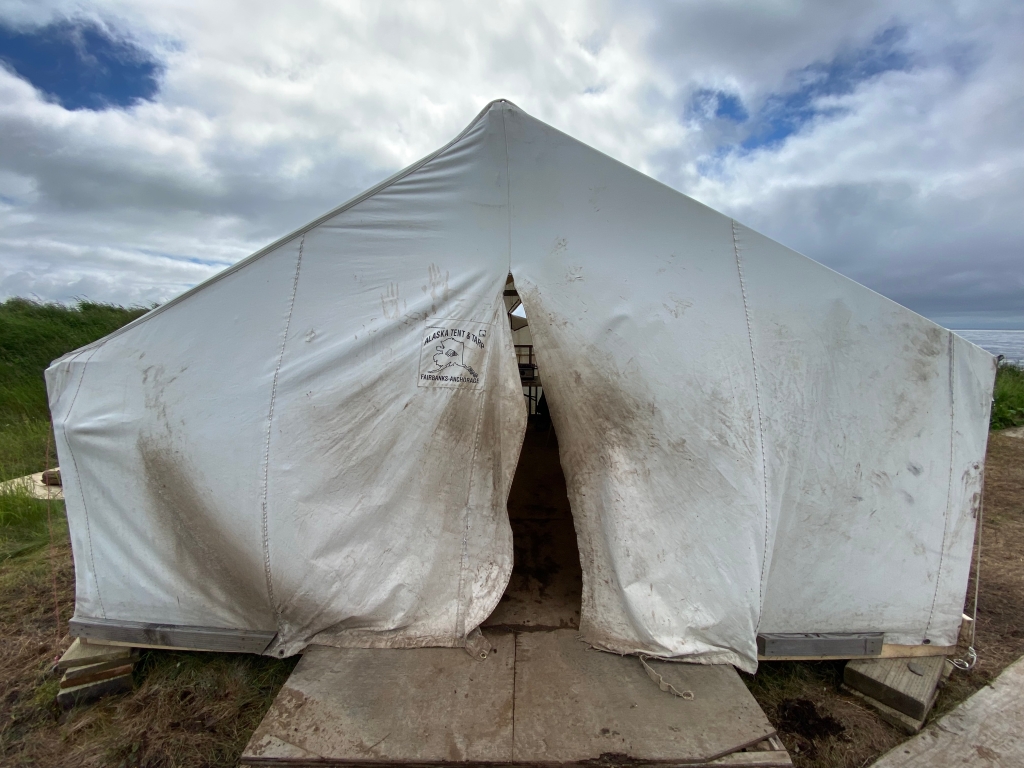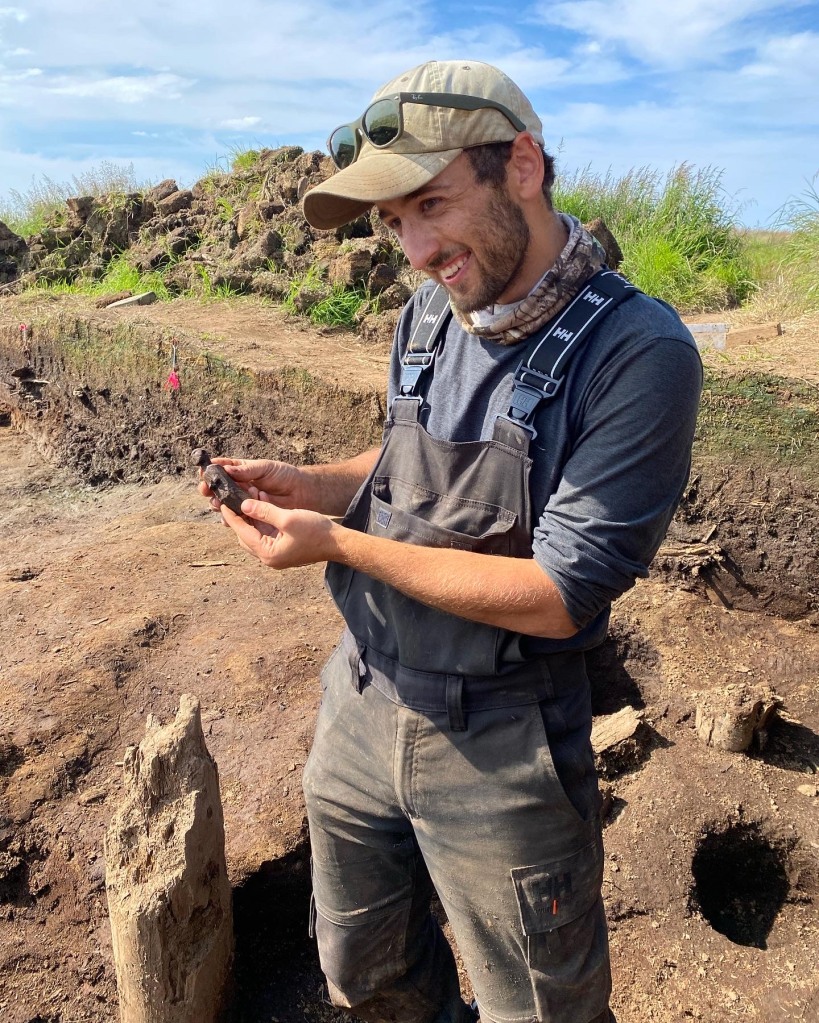Off Season Fieldwork


Back in April Anna and Alice spent a week in Quinhagak, catching up with friends and colleagues (and of course getting some work done!). Anna ran a dance fan making workshop led by Elder Annie Don, while Alice began work on plans for a new tablet guide for the Nunalleq Museum together with Sean and Lynn.
Dance fan workshop (Anna)
The idea of holding a dance fan making class in Quinhagak had been brewing for several years. Dance fans or tegumiak are an important part of Yup’ik dance regalia. By extending dancers’ hand movements, dance fans help tell stories and illustrate the dance lyrics. Decorated with furs and feathers, several styles of Yup’ik dance fans exist. It was, therefore, decided to have two dance fan making classes: one teaching how to carve dance fans out of wood and another one on how to make them with coiled grass. Last summer, Alaska Native mask maker, Drew Michael led a class on wooden dance fans (check out the video!).
This time, Quinhagak-born Elder Annie Don taught how to weave grass dance fans. The grass that participants used during the class was collected on a local beach by the late Grace Anaver. The class was held in memory of Grace, who knew and shared much about traditional Yup’ik crafts.
A four-day class attracted a lot of interest and gathered 14 participants in total. The event was truly intergenerational: students’ ages ranged from 11 to 60+. It was incredible to see grandmothers making fans together and for their granddaughters. The timing was perfect too: the following week, Quinhagak school was going to perform at the dance festival in Tununak and some dance regalia was very much needed!
None of the participants had made dance fans before and Annie did an amazing job teaching participants how to weave beach grass into flat round bases (meticulous and delicate work!) and how to cut and attach reindeer fur to the grass. The reindeer neck fur for this class traveled all the way from Nunivak (thanks, Warren!). The results of the class went beyond any expectations—just see yourself!









This project has received funding from the European Union’s Horizon Europe research and innovation programme under the Marie Skłodowska-Curie project nr. 101063760, Collab4Multi. The workshop was made possible also with funding by Rasmuson Foundation through the Youth Cultural Heritage Fund, and is administered by the Alaska State Council on the Arts.
Nunalleq Museum Tablet Guide (Alice)
Meanwhile, Alice began brainstorming the design and content for our new tablet museum guide which will support visitors and local teachers in navigating the many drawers of artefacts in the Nunalleq Museum. This was a chance for some of the core design team (Alice, Sean, Lonny and Dora) to sit down together in person for a few days and work through our ideas – and we have lots!
Alice also dropped by Kuinerrarmiut Elitnaurviat (the school) to talk about some of the resources we already have available (check out our Educational Resource from 2019 and our recently launched Digital Museum!) and to discuss how the new museum tablet guide can support classes coming in to visit the museum more regularly through lesson plans, etc.
Stay tuned as we continue to develop this exciting new project…



The digital museum guide project is funded by a grant from the Institute of Museum and Library Services (IMLS).
Nunalleq 2024 Field Season
Plans for this summer include both excavation and lab work and you have the opportunity to participate in both either as a volunteer or a field school student. Follow this link to apply: https://nalaquq.com/nunalleq-archaeological-project-2024-season/
Nunalleq Field Season 2023 – Wrapping Up
(Pictured above) The field tent and main trench. At the time of these photos, the boardwalk had just been unearthed and several layers of house-floor were soon to follow.
(Pictured below) Important finds such as ulu blades, dart shafts, grass braids, arrowheads, masquettes, and animal remains

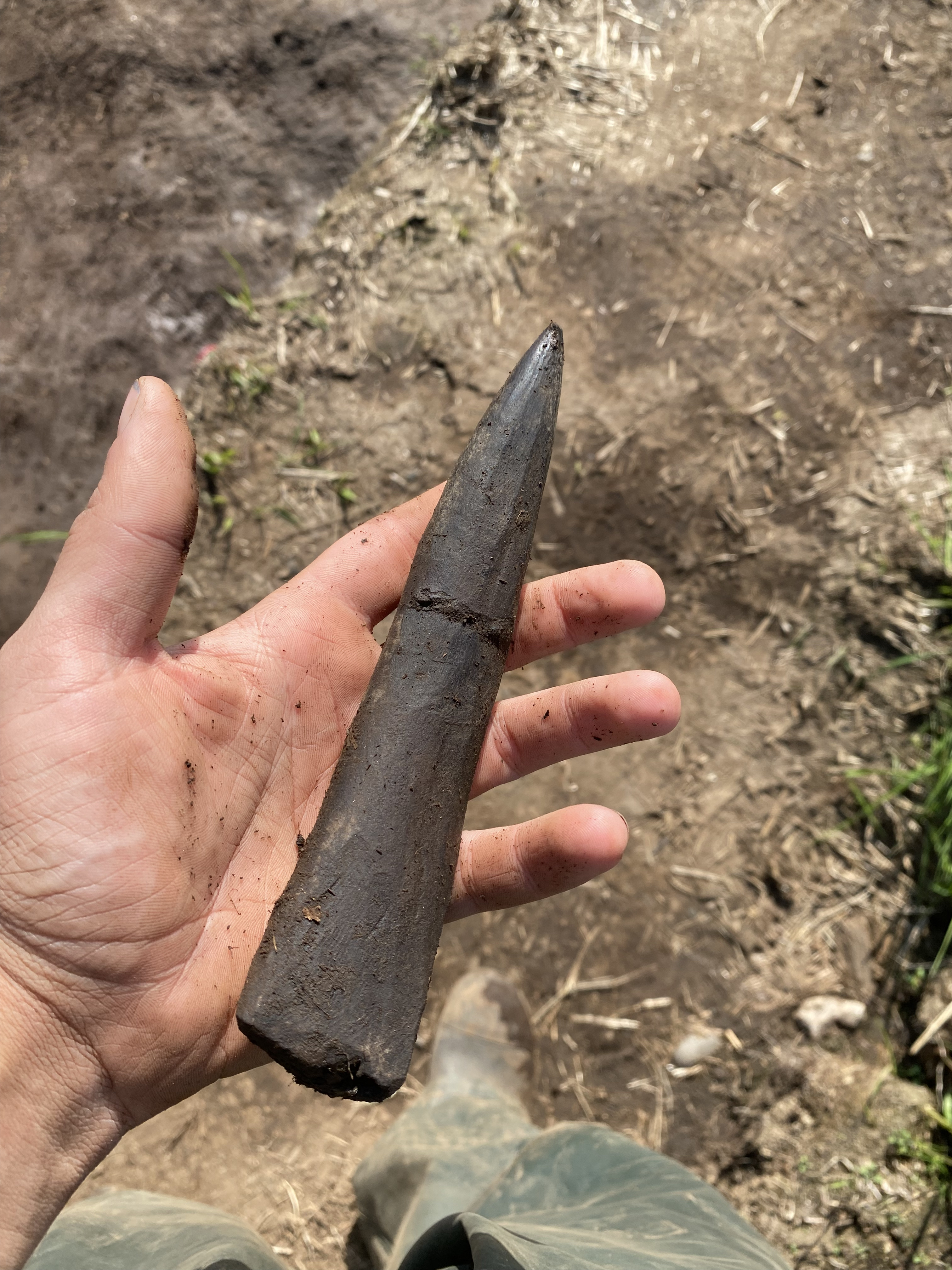

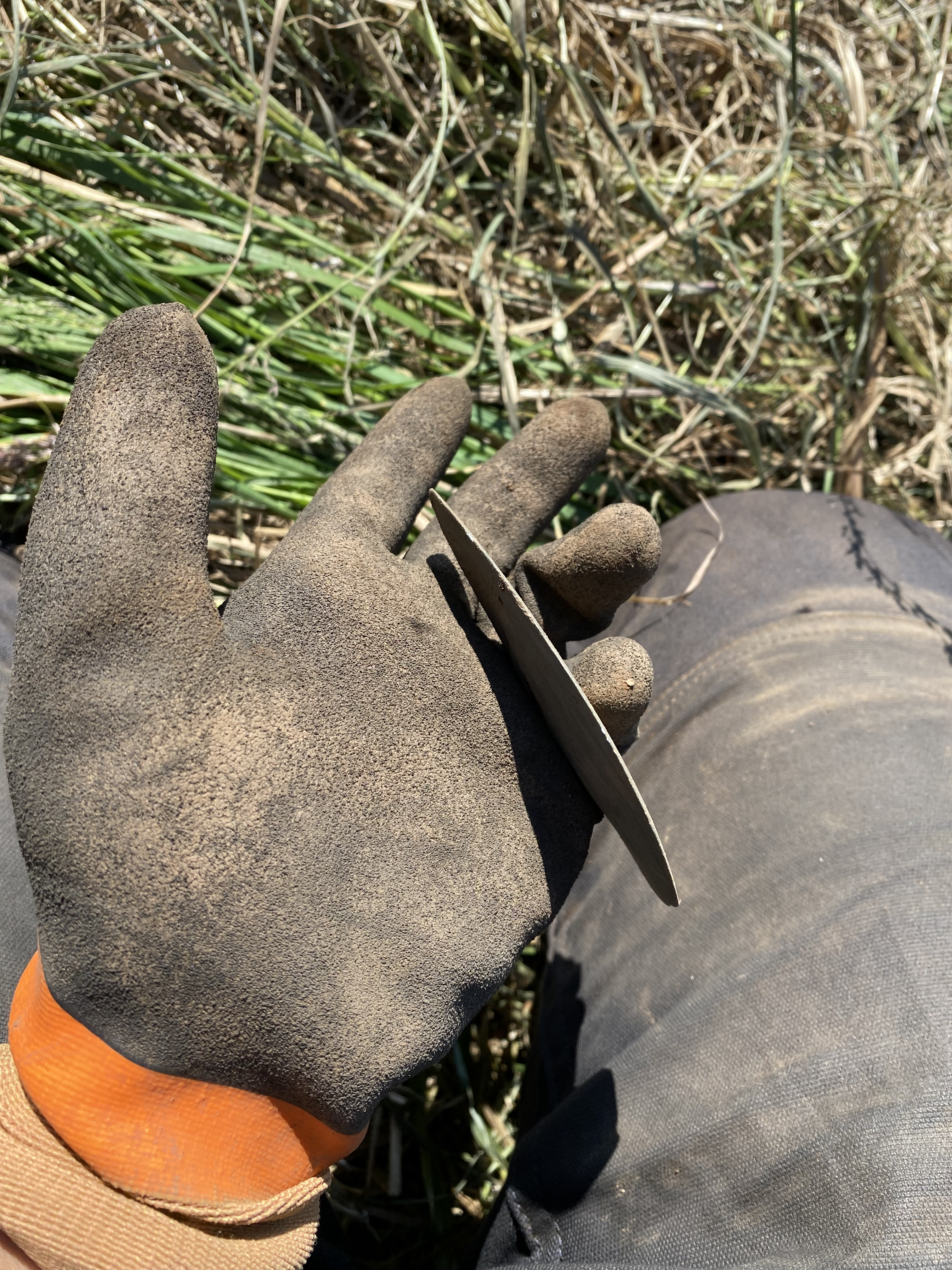




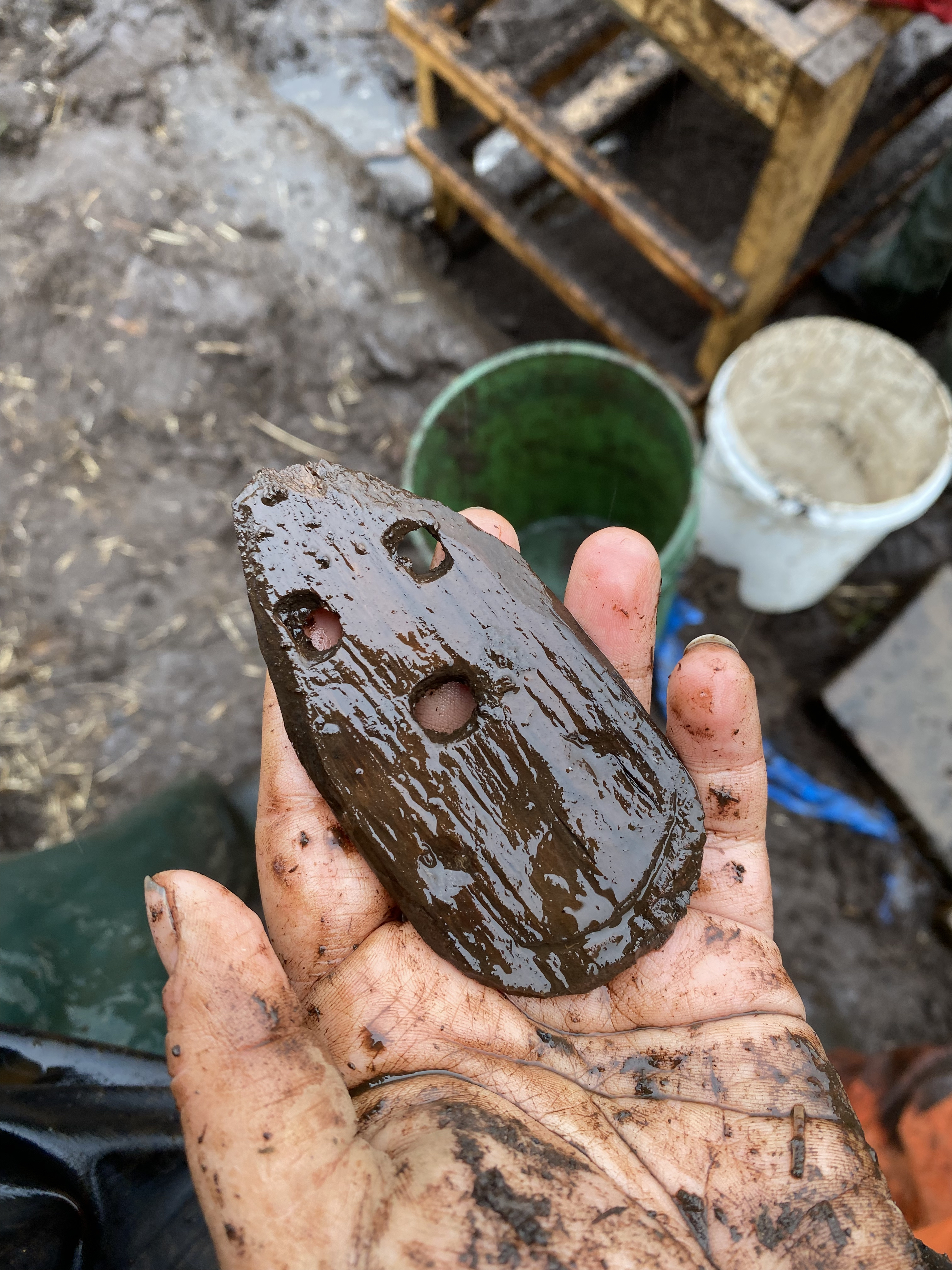


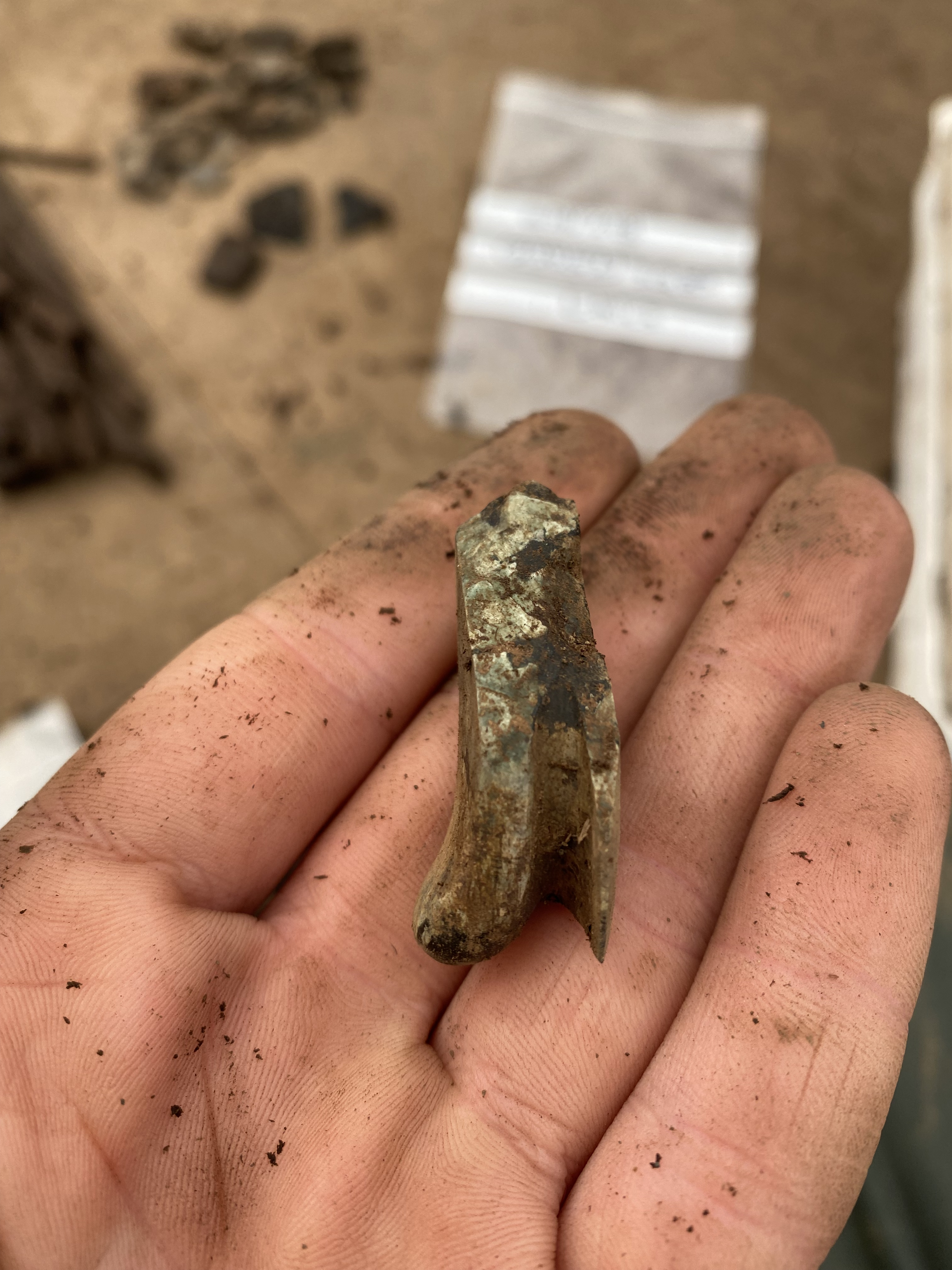
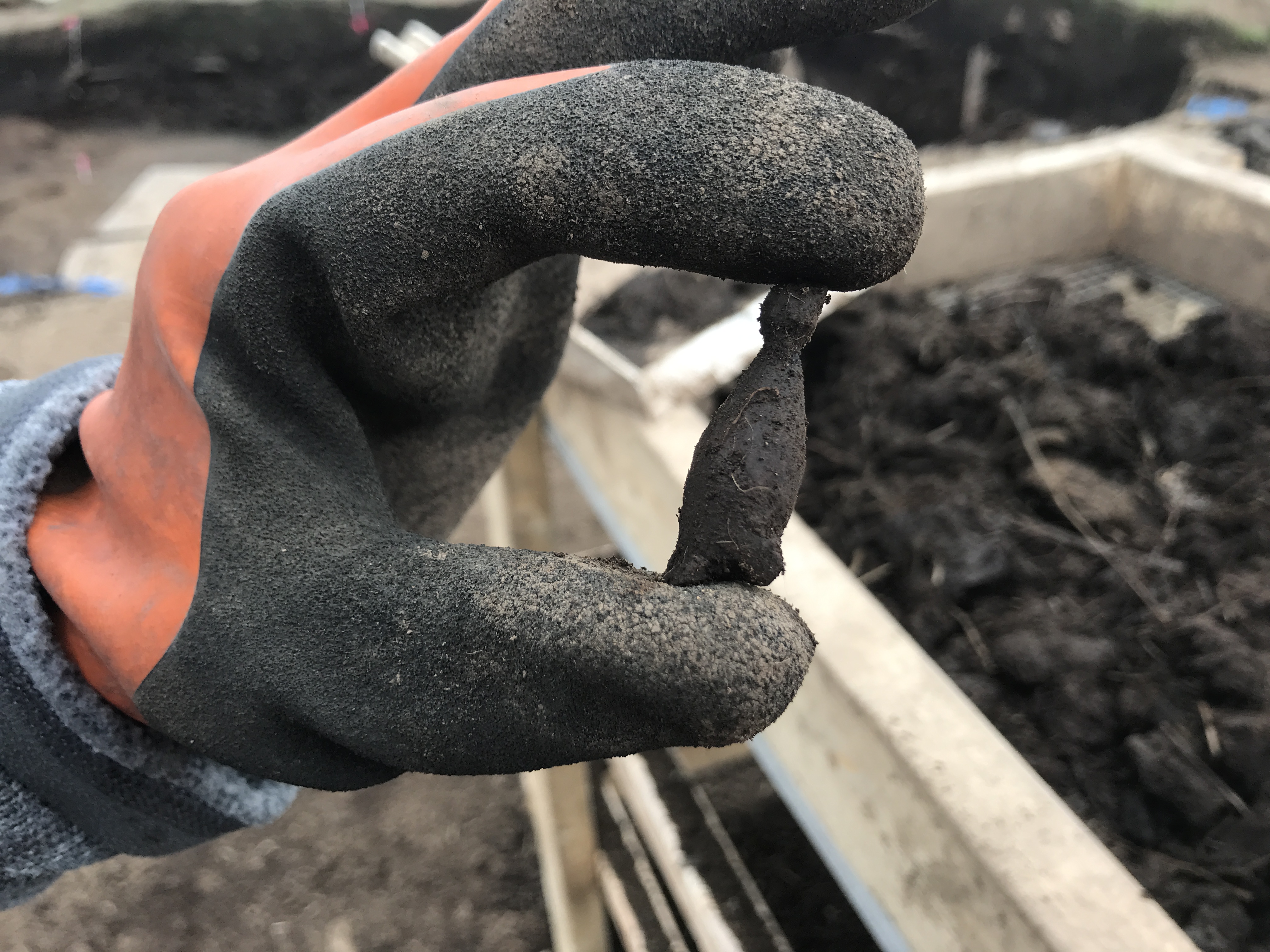

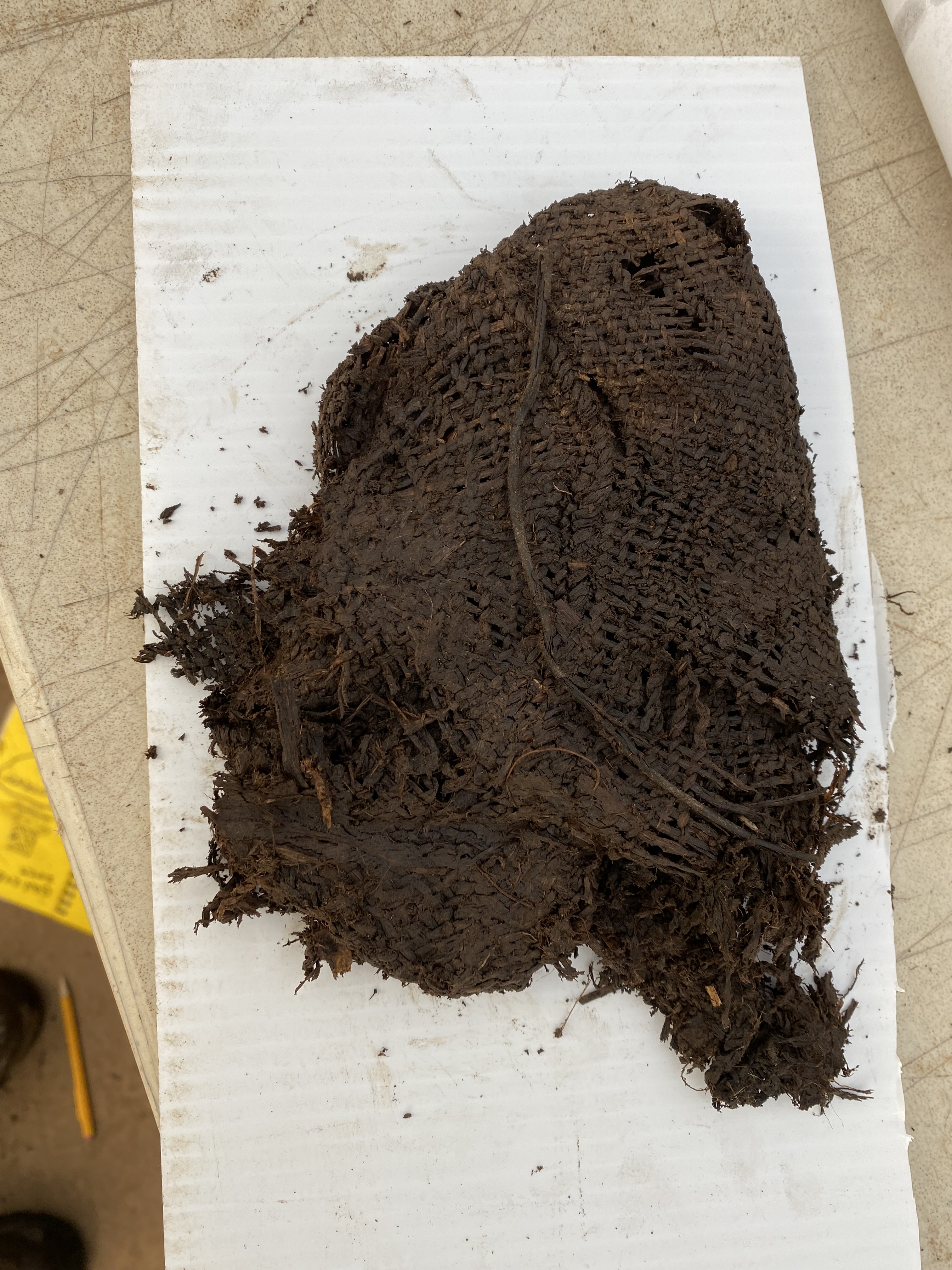

While digging at the Nunalleq site, we were visited by John Smith, a village elder and master ivory carver. Noticing the general confusion about a pile of wood shavings, John informed us that these were traditionally used as sandpaper, rubbed on wooden objects to create a smooth surface.
John Smith’s assistance is just one example of the larger Quinhagak community providing us with the knowledge of their ancestors and explaining how artifacts would be utilized in pre-contact Yup’ik life. These moments reflect the heart of the Nunalleq Archaeological Project – working alongside the Yup’ik people to help facilitate the connection with their heritage, which was nearly severed by colonialism. Despite such attempts, the Yup’ik people and culture are not lost to history but remain alive and just as innovative as their ancestors.
The discovered artifacts will remain in the village, housed in the Nunalleq Museum. The museum creates a space for the villagers to gather, feel connected with their heritage, and reclaim a narrative which they had been prevented from possessing.
Community-based archaeology practiced here allows for a much deeper appreciation of the artifacts and for the people who made them. With the incorporation of Indigenous knowledge, we become better archaeologists and reaffirm the importance of learning about the past.
This seal mask, found by Hannah Strehlau, came within centimeters of being found on multiple occasions. First by looters, likely in the 60’s, and then again more recently during a previous field season. However, it seems that it was not ready to be found until now! The mask was located in an area which will be eroded by the Bering Sea sometime in the next few months. Its location highlights the harmful effects of climate change and the urgency of the Nunalleq Project.

(Pictured below) William Powell finding his first fertility doll on one of the rare sunny days! – looks as though it could have been carved yesterday!
The anticipation of unearthing the next incredible find made it difficult to escape into the tent for our daily lunch of Cup Noodles and Nature Valley Bars. However, when a furry friend wandered onto the site, there was no hesitation in putting down the trowel!

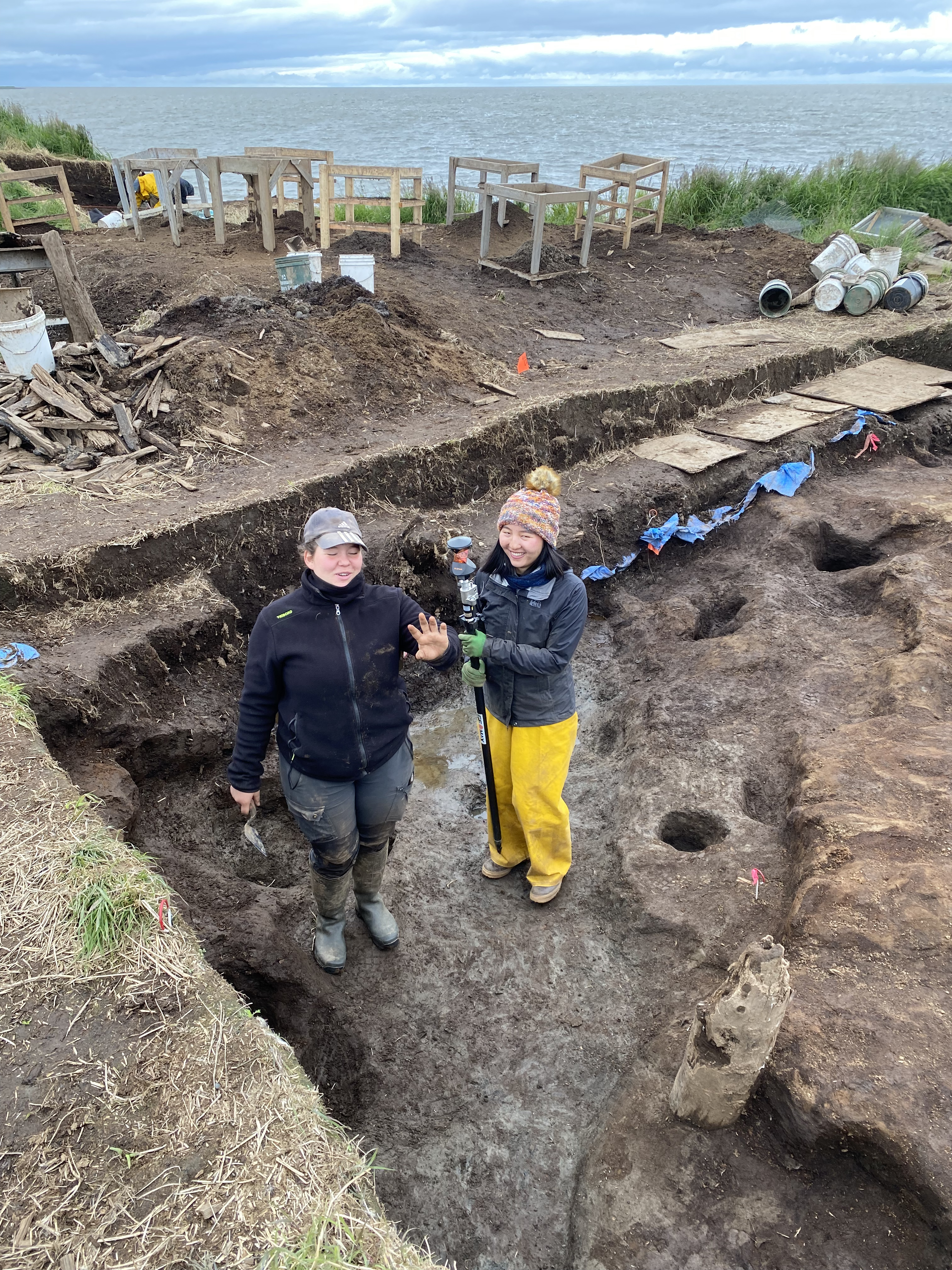



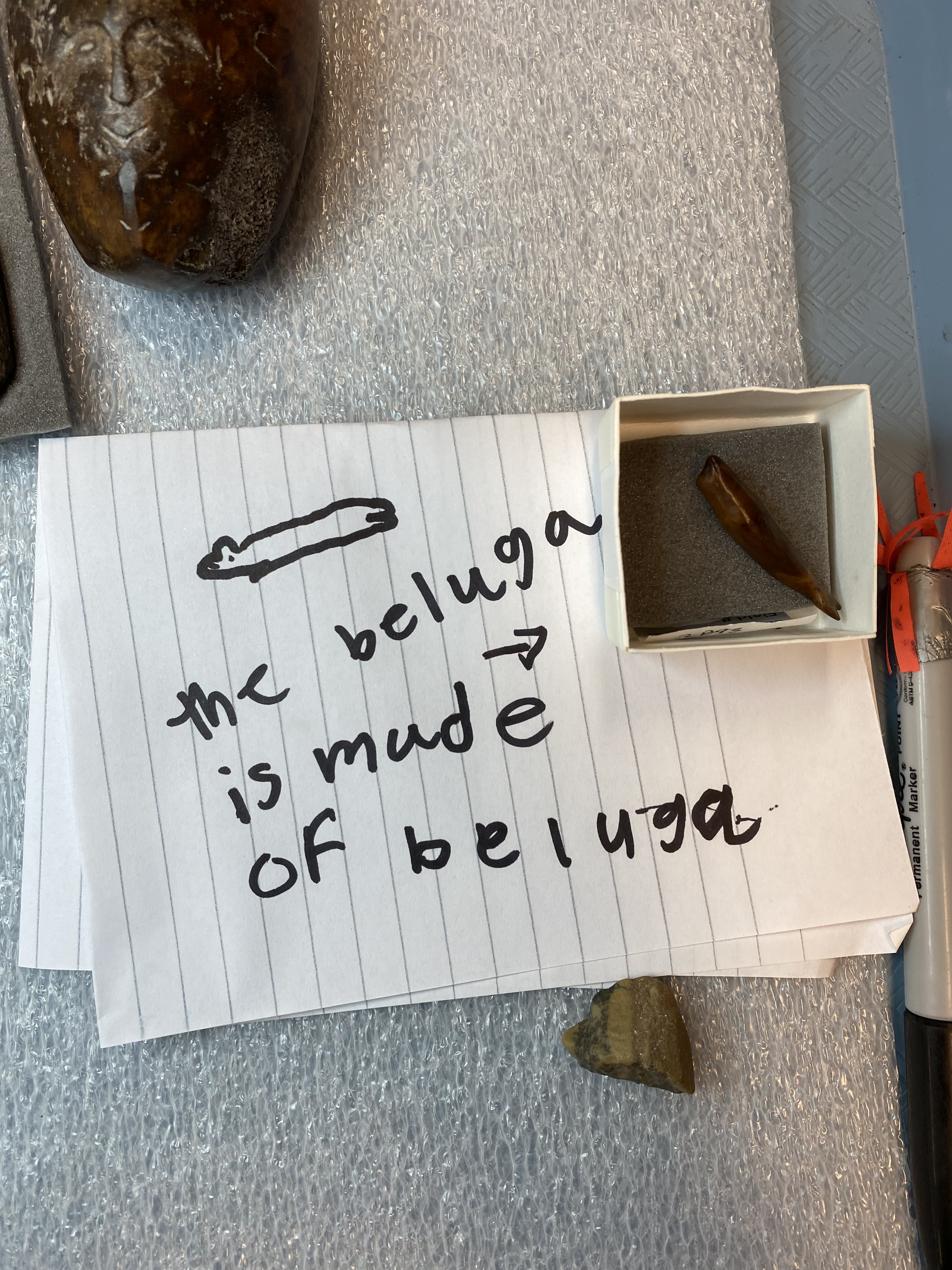
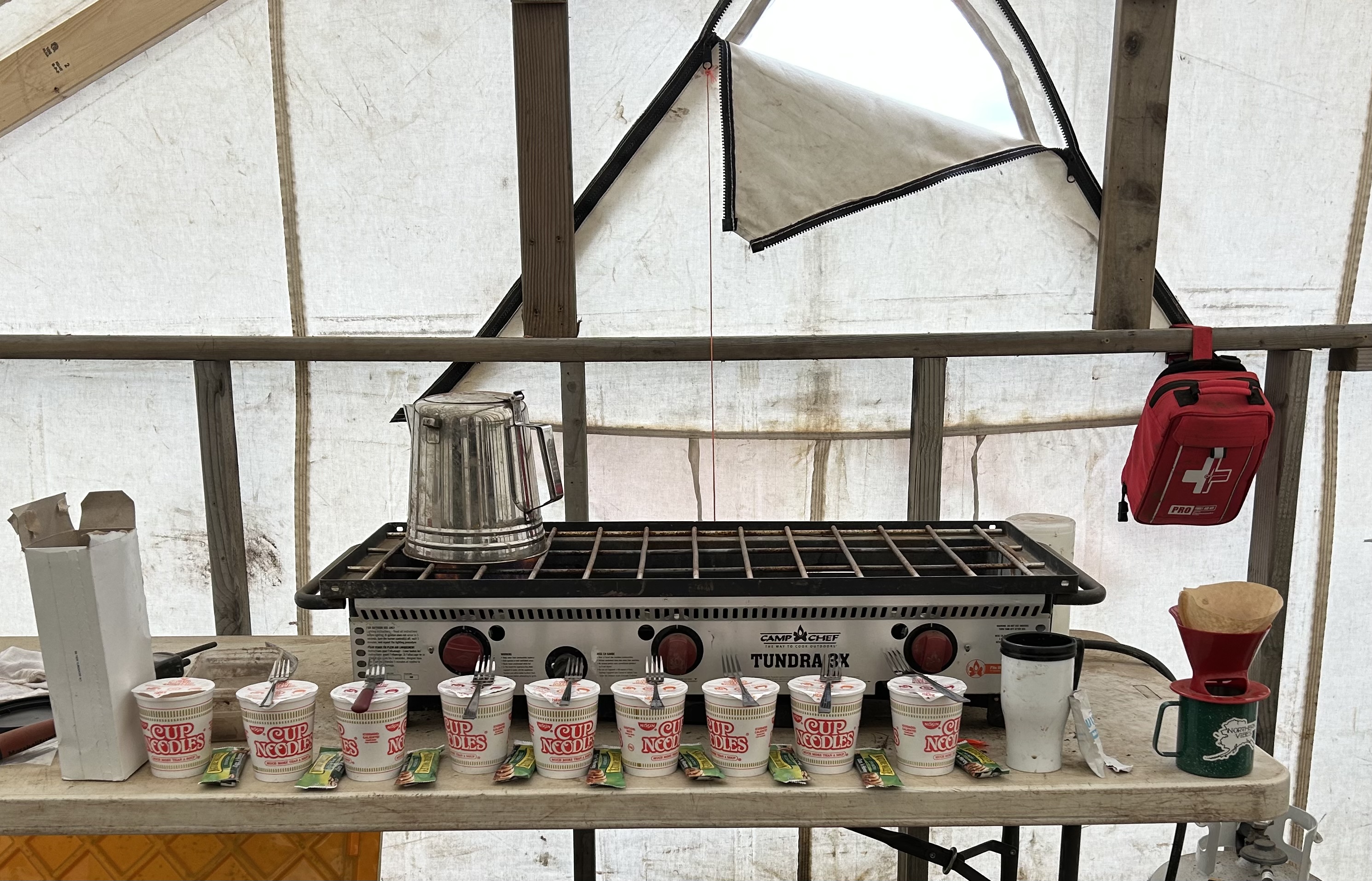



Spending time in Quinhagak means we get to experience one of the most beautiful places on Earth.




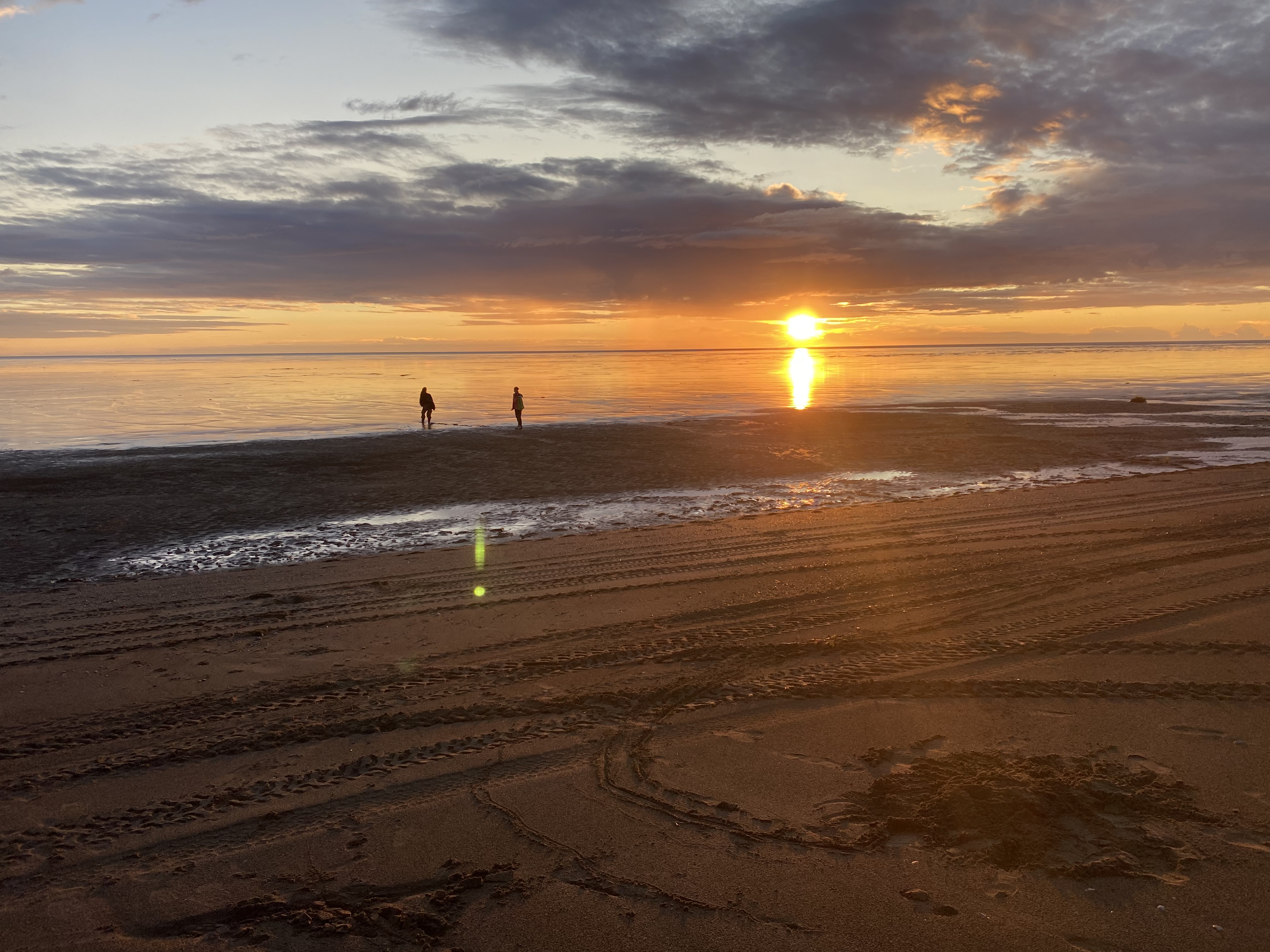
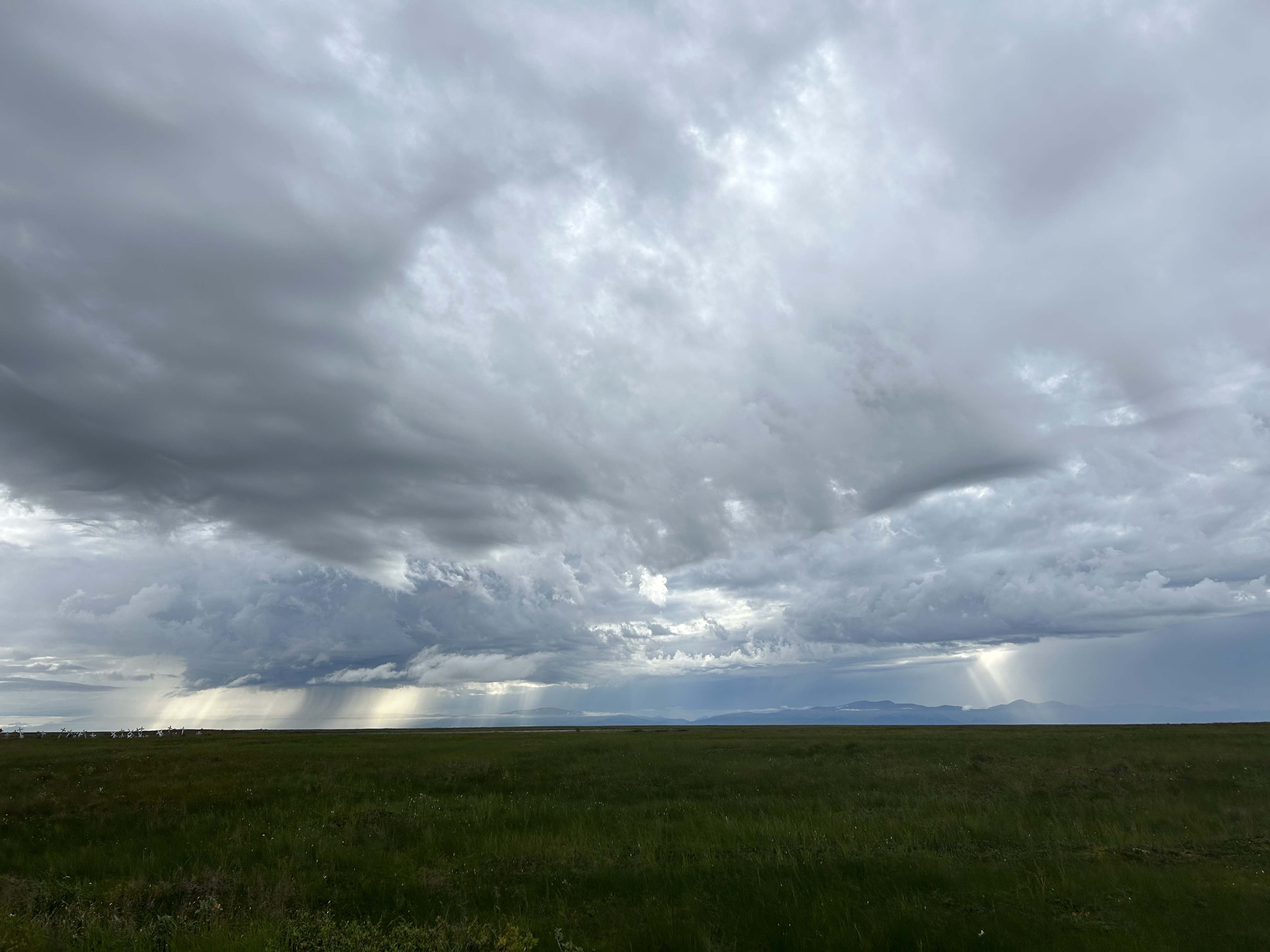





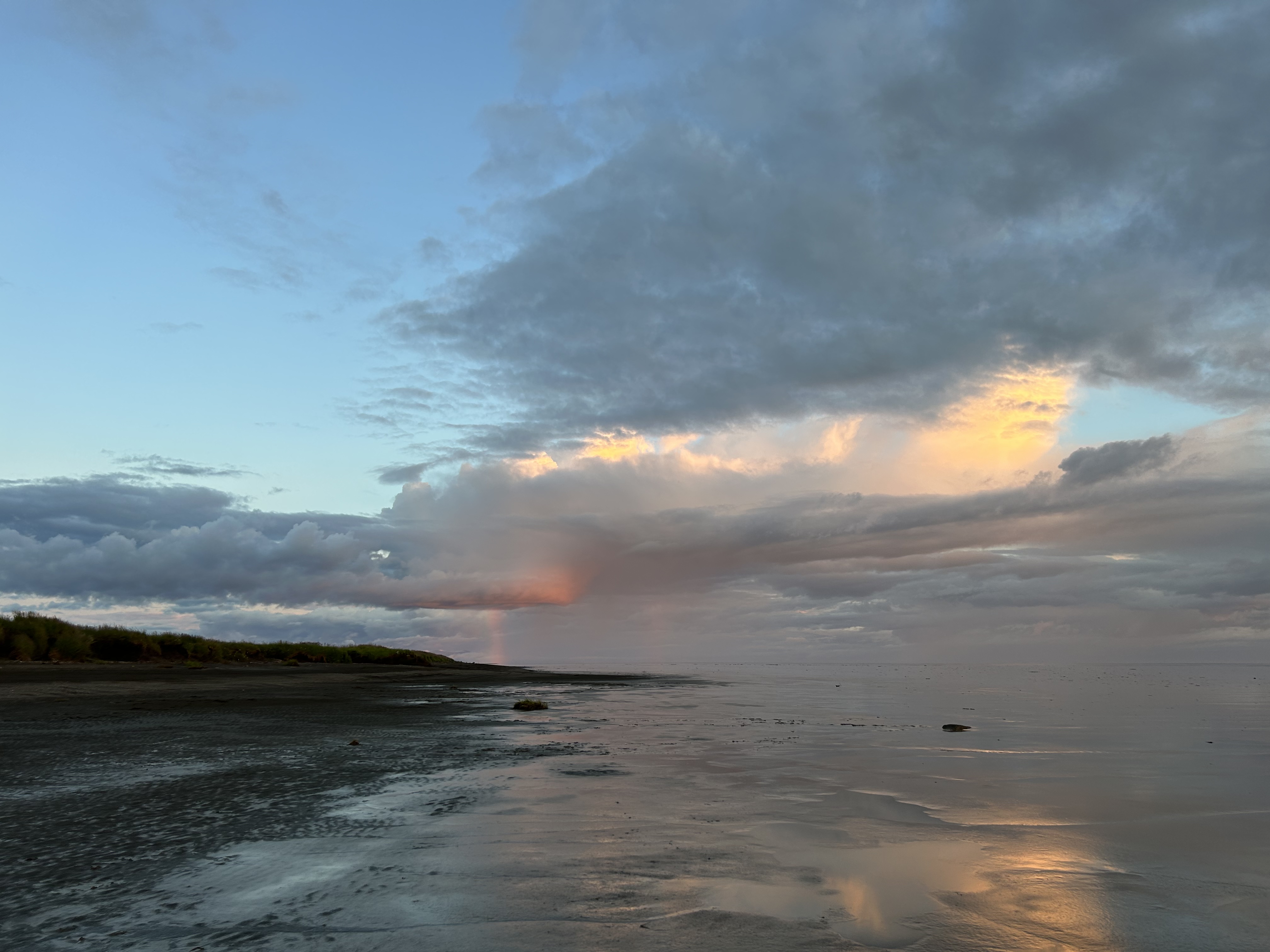





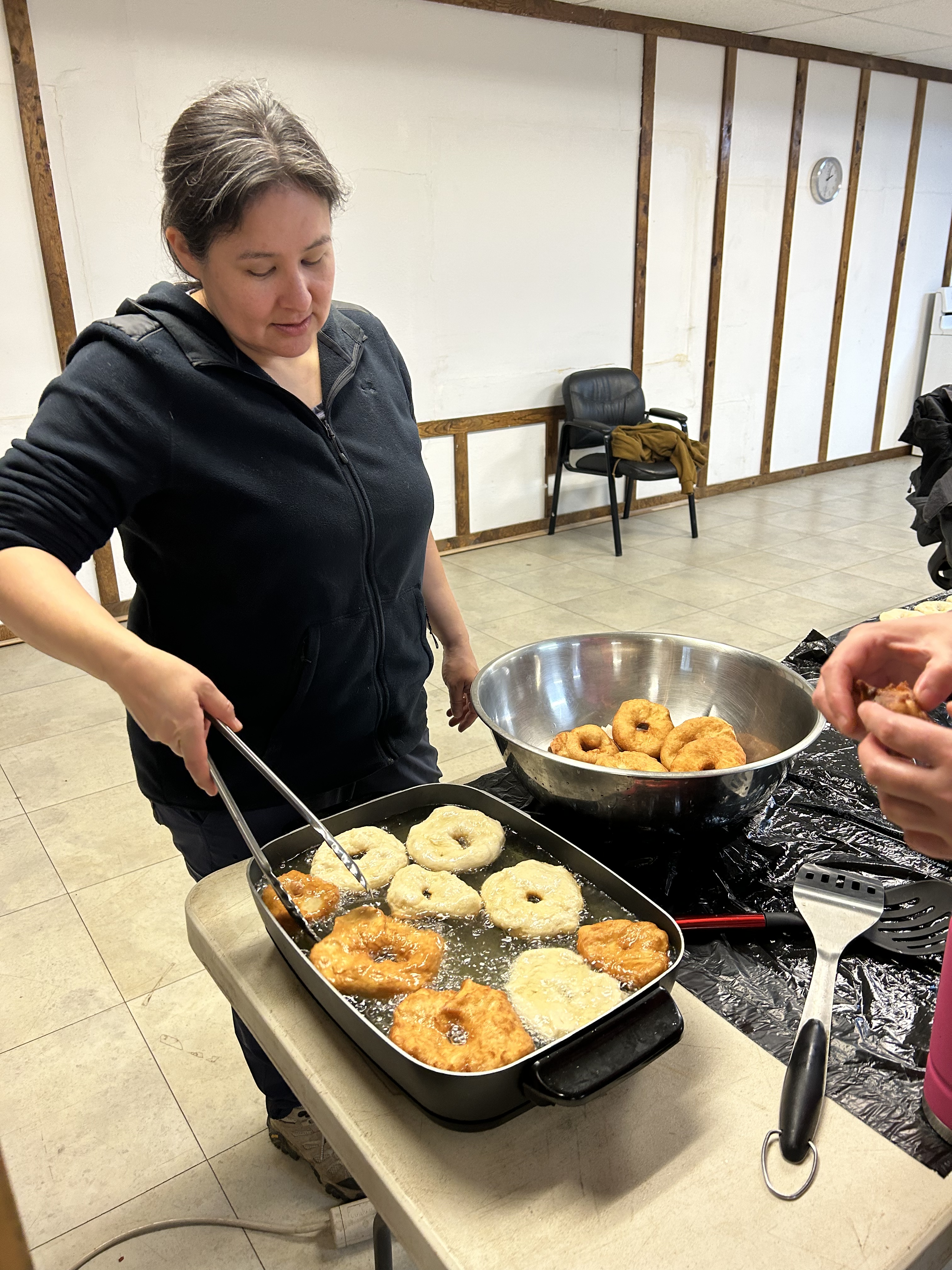
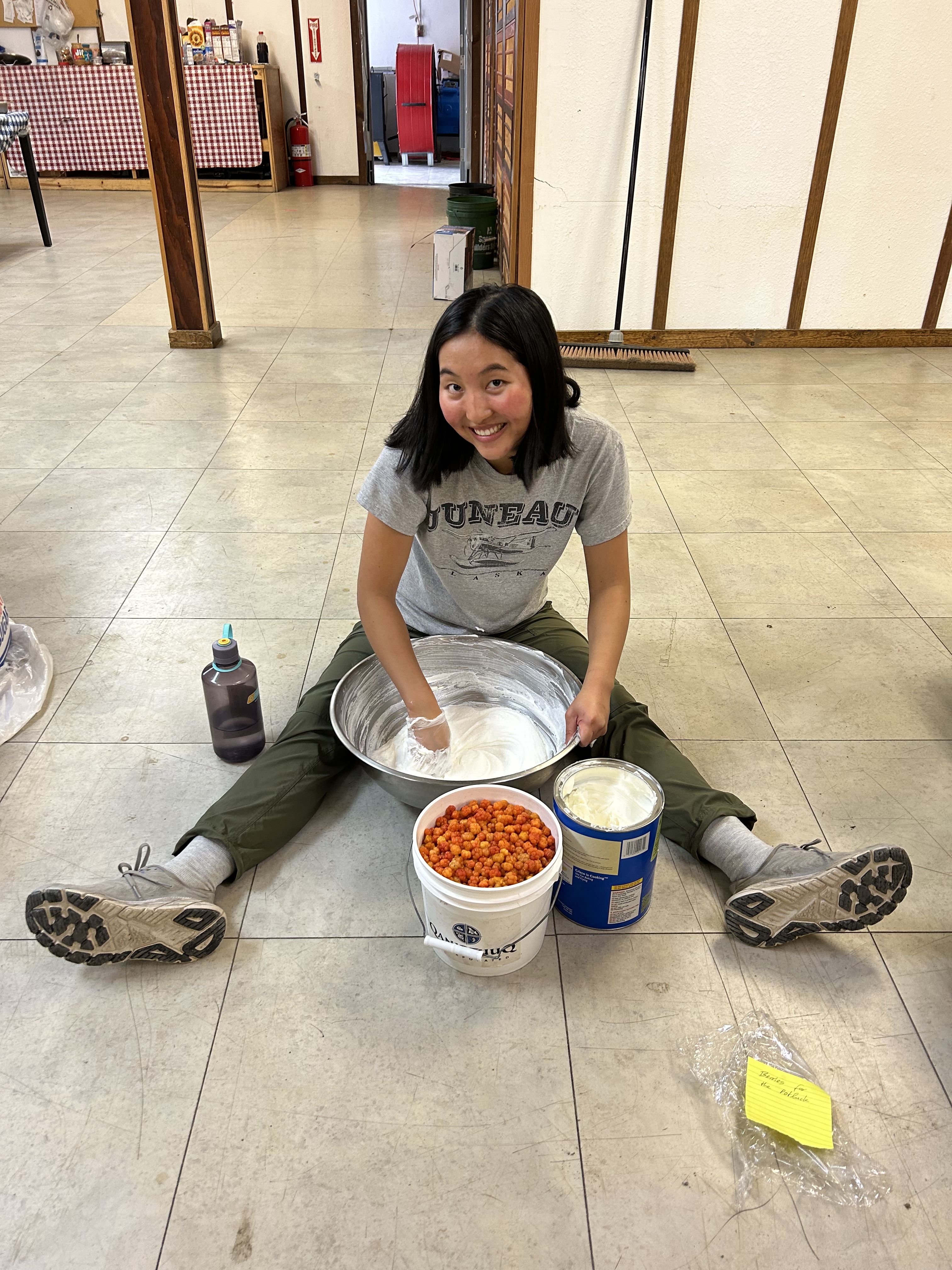
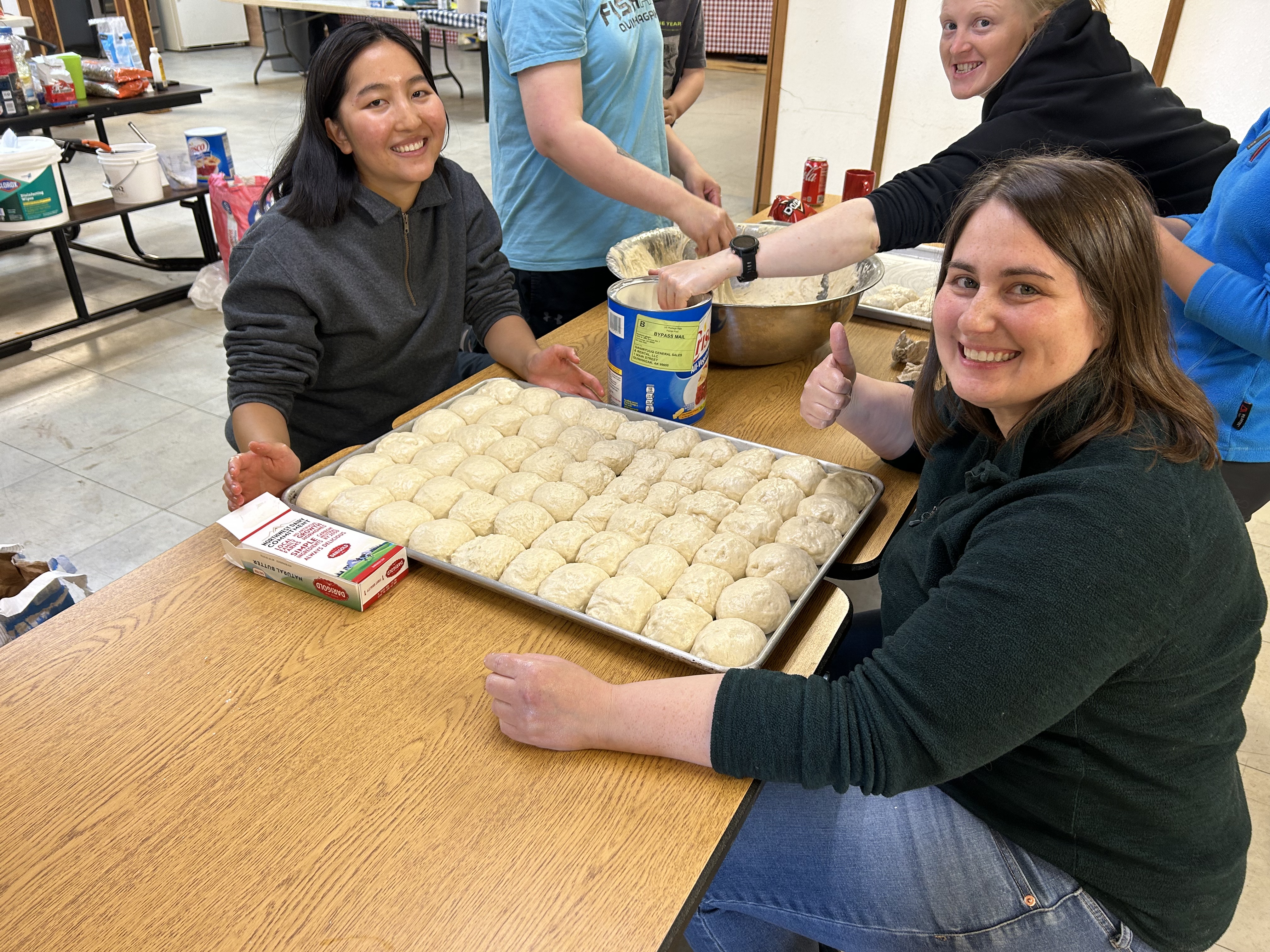
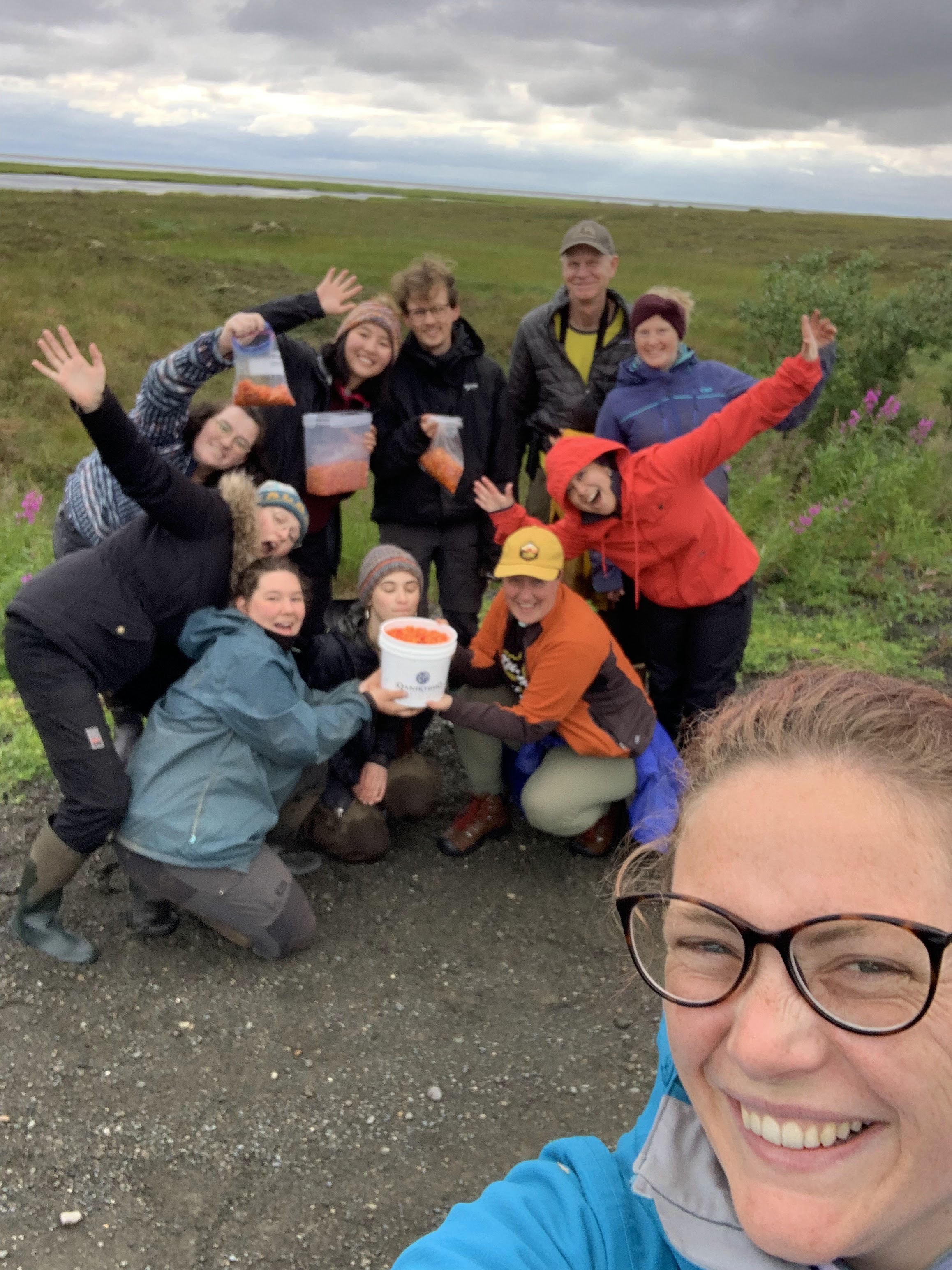



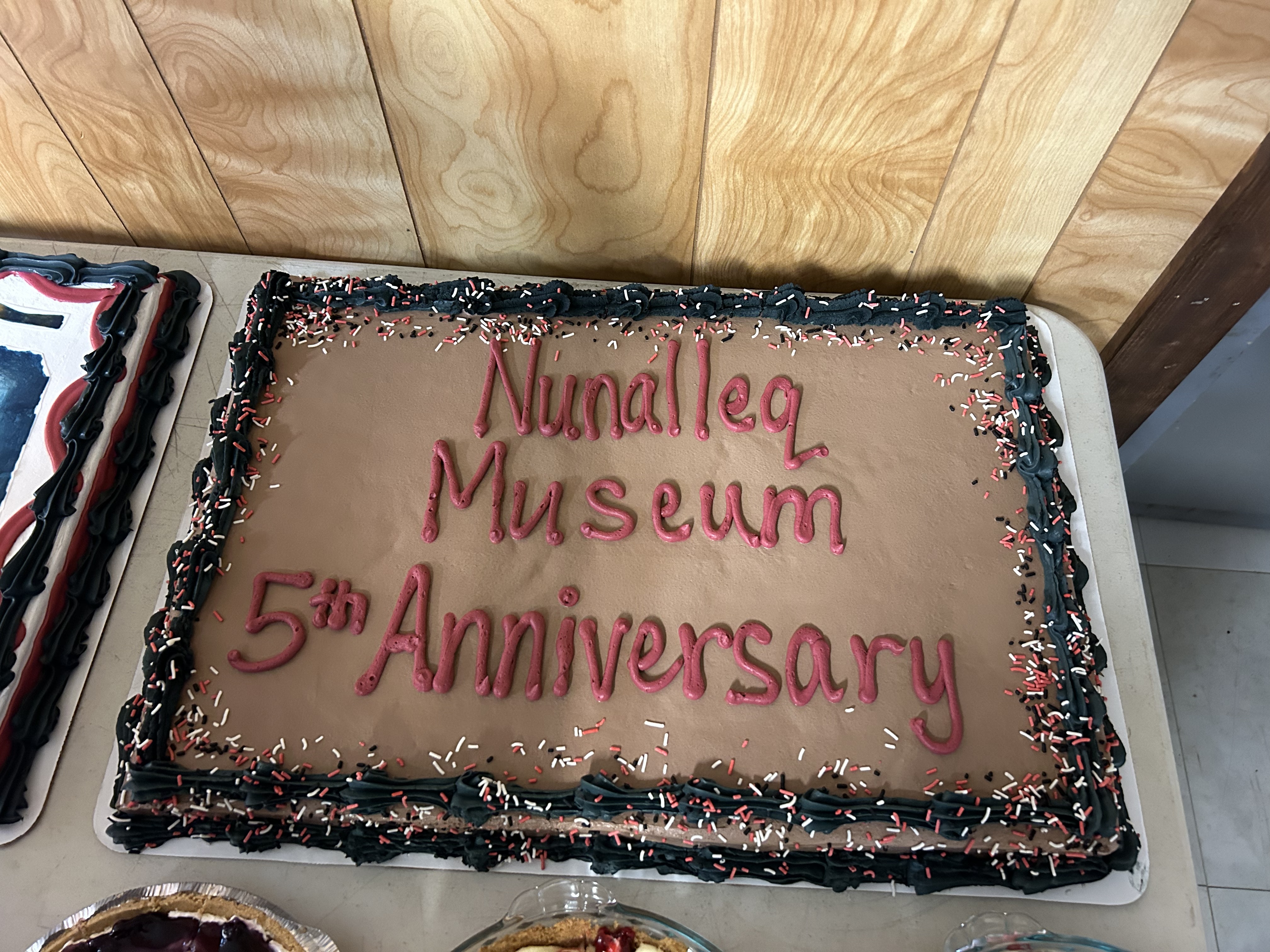
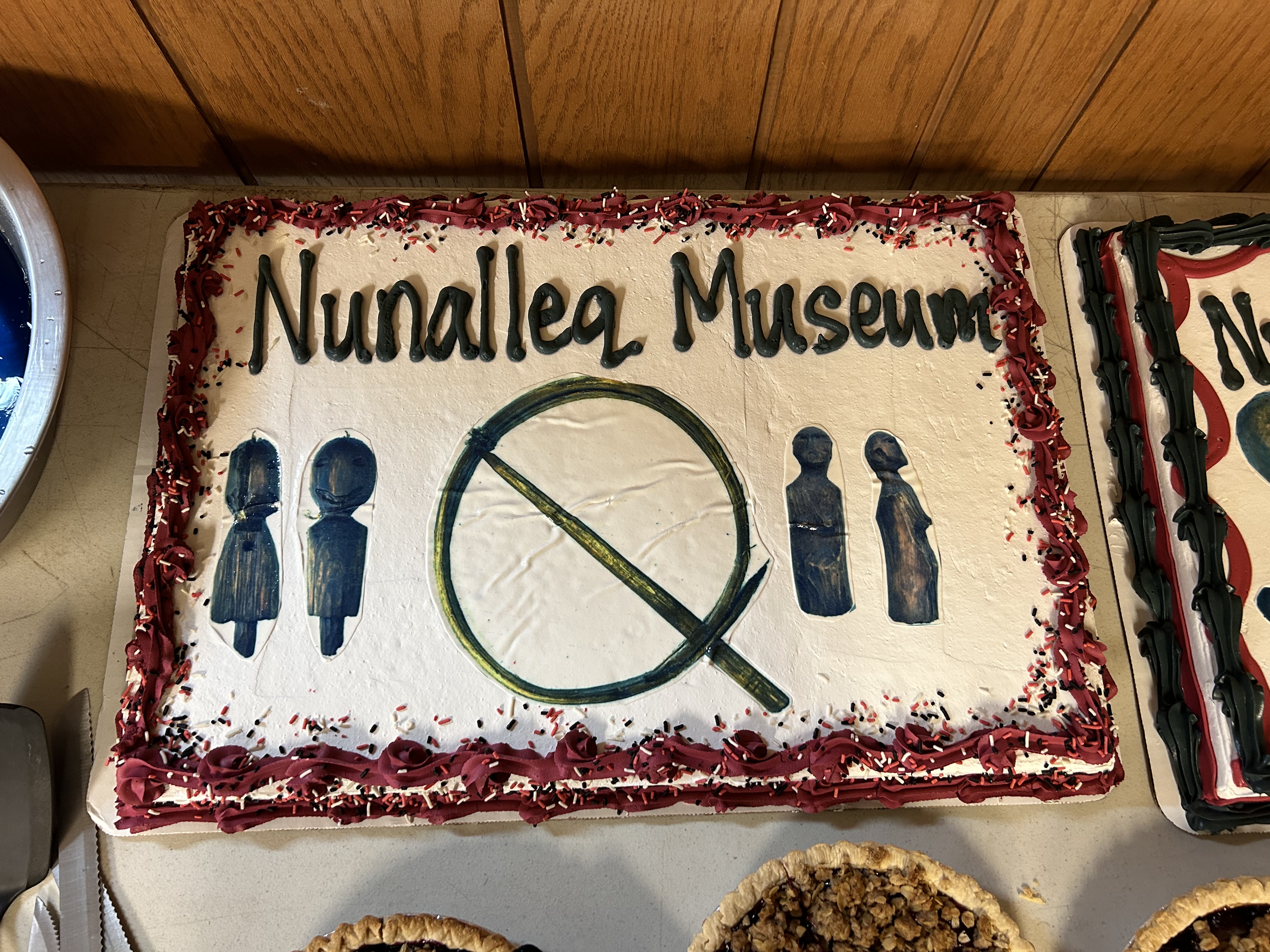
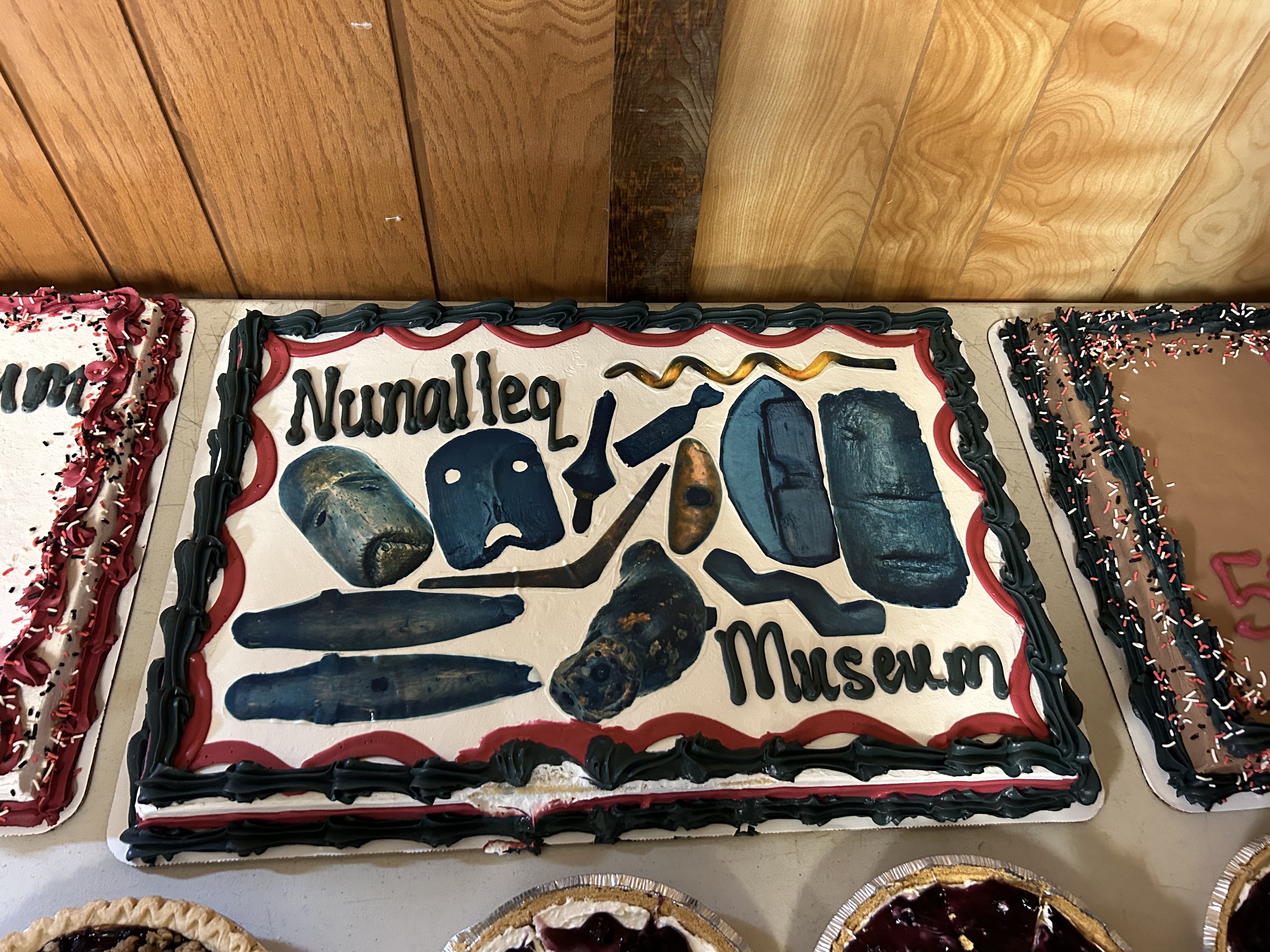
To celebrate the conclusion of the 2023 season and the 5th Anniversary of the Nunalleq Museum, a potluck was held for the entire village of Quinhagak!
To help prepare, we had the special treat of learning how to make Yup’ik foods such as frybread and akutaq, or Eskimo ice cream. The fluffy frybread in Quinhagak is in the shape of a donut. However, volunteer and Yup’ik artist Jen Angaiak Wood (pictured above) told us that in other Yup’ik villages, the bread is shaped differently. Her grandmother’s recipe called for multiple holes and was crispier as a result. Akutaq, meaning mixture, was traditionally a mix of seal oil, snow, and local berries. To prepare this sweet treat, we went out and gathered ripe salmonberries, a local delicacy. Nowadays, akutaq is made with ingredients such as Crisco, Cool Whip, sugar, and mashed potatoes. Ginny and Rebecca (both pictured above) both tried their hands at making akutaq. After about 45 minutes of mixing by hand, they discovered that making akutaq is truly hard work! Akutaq has been a favorite dessert of the team throughout these past few weeks, and we have enjoyed trying all the varieties!
To represent the international composition of the team, some of us made food from our home countries. Fernanda (pictured above), who is originally from Mexico, made churros. We absolutely loved the three beautiful cakes made by the village store for the occasion. The village also came together to make traditional foods such as seal ribs, walrus soup, whale, and moose. Thank you to Alexis and Lynn for making the potluck happen!
These past few weeks have been some of the most inspiring, impactful weeks of our lives. They have left an indelible mark on us and have given us wisdom and connections which we will carry throughout our careers and lives. Quyana to our mentors on the site and to Quinhagak for welcoming us so warmly!

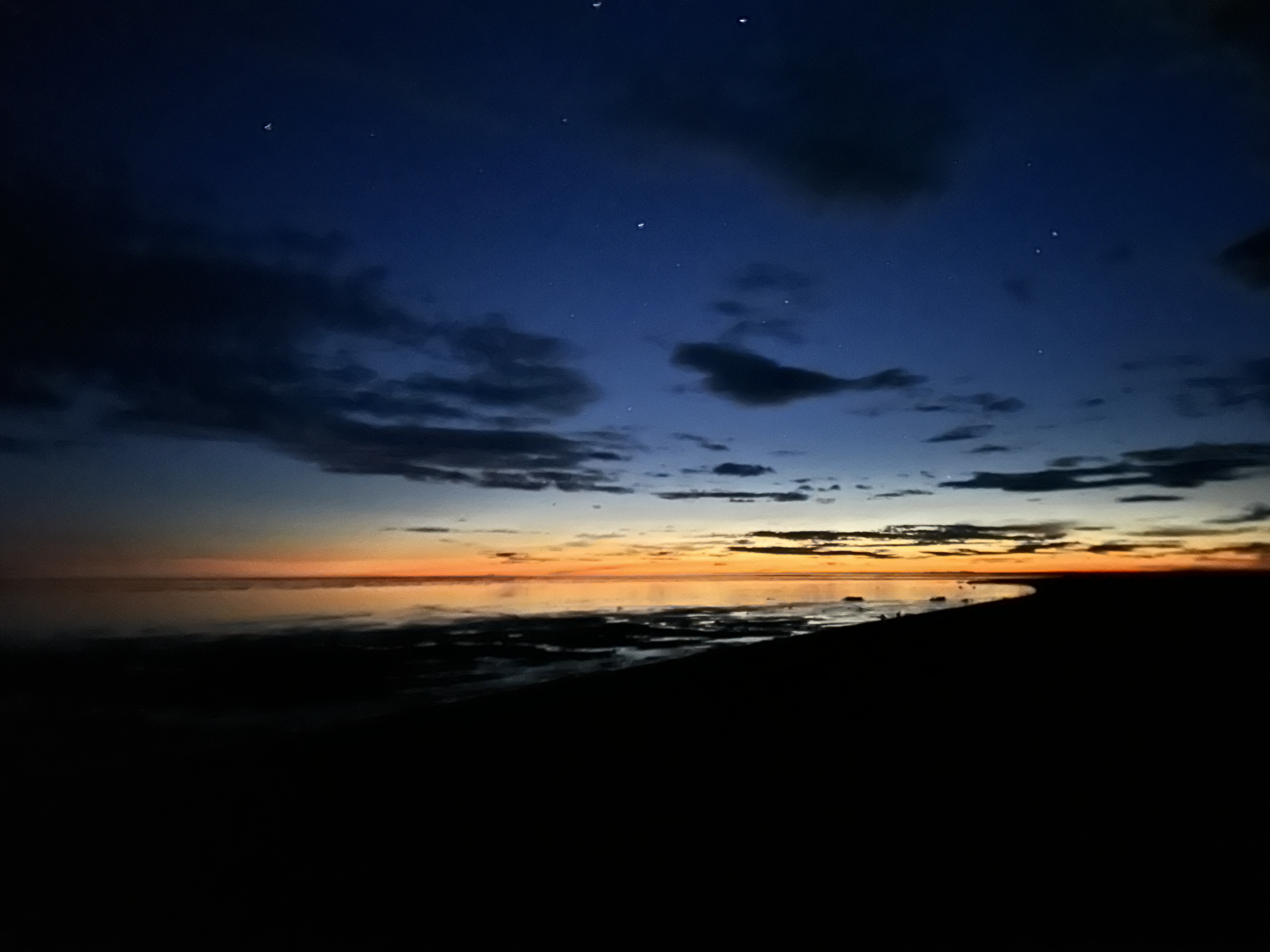

~ THE END ~
Text and photos by William Powell, Ginny Sunde, Karoline Hobock, Emmett Culmsee
Celebrating Nunalleq Museum’s 5th Anniversary!
Nunalleq Museum is turning 5 years old this year! To mark the day we planned a ‘show and tell’ at the museum, followed by a potluck and performance by the Nunalleq dancers.
We spent the morning setting up for the ‘show and tell’ in the afternoon. Rick picked a range of artifacts to show from the 2023 excavation at Nunalleq. Wood masks, dolls, and other artifacts – many still in the process of conservation – were set up on one table, while antler and ivory harpoon pieces, stone labrets, and more lined another. Elders and community members were invited to look at and handle artifacts from Nunalleq, opening conversations about how they were made and what they were used for. Monica Shah, Janet Northey, and Stephanie Black (conservators from Anchorage Museum) offered insights into the conservation process – where water within the wood is replaced with polyethylene glycol (PEG) to ensure the artifacts do not fall apart. In the collection room, Rick talked with visitors about the artifacts excavated this summer and compared them to artifacts found in previous years. Community members offered their own thoughts and knowledge on what many of the artifacts were used for.
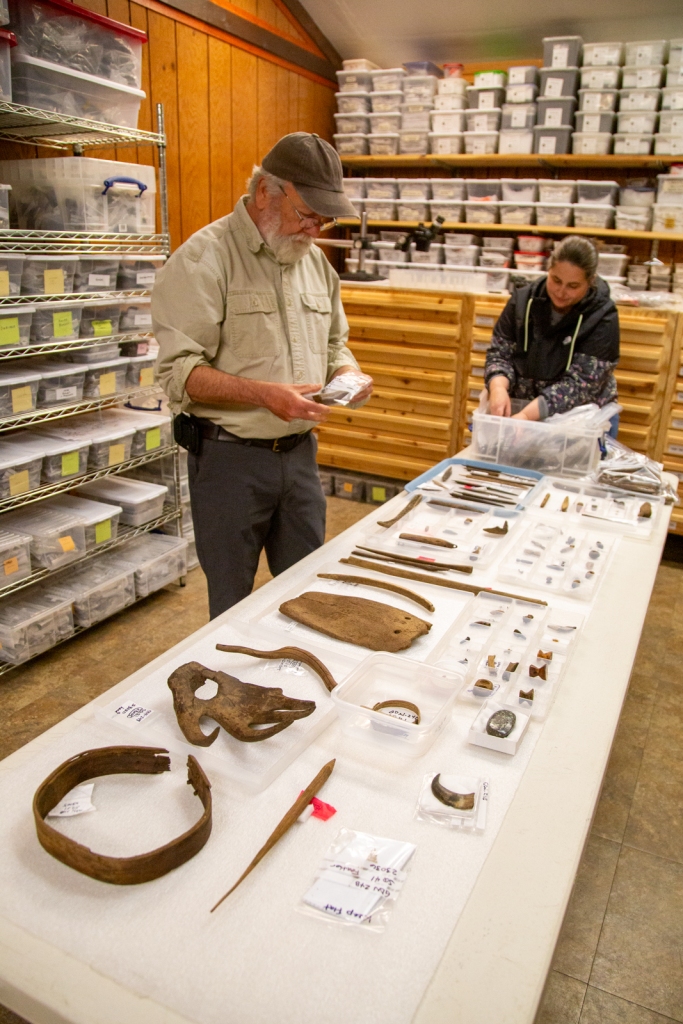


We also set up a science station, complete with magnifying lamps and a microscope. Kids who visited the museum were invited to make their own slides and look through the microscope at the cellular structure of wood from Nunalleq. Small sampling sticks topped with bits of sandpaper were gently rubbed against Nunalleq artifacts to mimic sampling for ZooMS – a method for determining what animal the artifacts were made from using mass spectrometry. Quinhagak has many young scientists in the making!

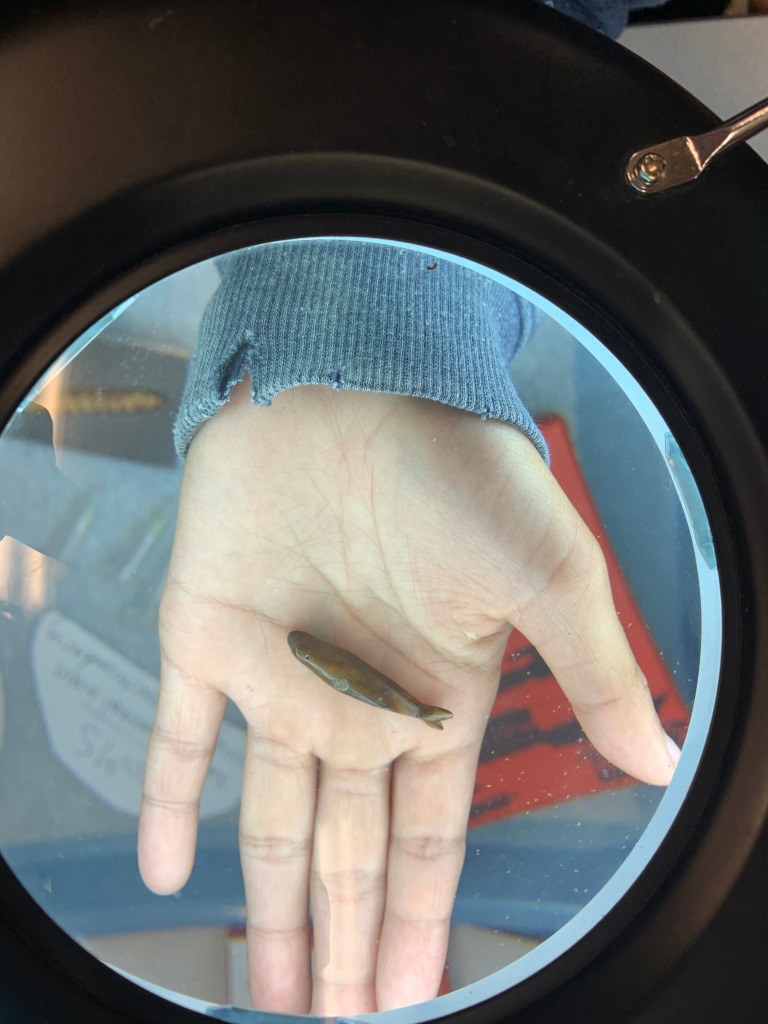
The day continued with a rich potluck: check out the menu in the video below!
Quyana to Alexis Jones, Lynn Church and other cooks and helpers who made it happen!
The Nunalleq Dancers played to a full house showing off their new fancy dance regalia: the kuspuks and dance fans that were made this summer during the classes with Catherine Beebe from Quinhagak and Drew Michael, a mask maker from Anchorage. The drums were made last year in a workshop with Baista (see previous posts on the blog). They performed four songs, including their famous Nunalleq song and ‘Quyana’, an invitational dance they learned from Chuna McIntyre 5 years ago. Lots of people joined in and danced with them. We had a blast!

PS: This pair of dance fans made from wood and trimmed with the neck fur of a Nunivak reindeer was made by Yup’ik artists Drew Michael and Jen Angaiak Wood. Drew and Jen have kindly donated them to the Nunalleq Museum for display and use by the Nunalleq Dancers.

Text and photos: Lindsey and Anna
5 years of the Nunalleq Museum!
Open Viewing at the Museum Today!
The Nunalleq Archaeological Project 2023 is composed of an international team of archaeology students, drone specialists, volunteers and professors of archaeology, coming from the University of Aberdeen, universities of Nantes and Franche-Comté, University of Oslo, Hampden-Sydney College and other US universities. The project runs from late June to late August, and this blog post is a rundown of everything we got up to during the first month!
In the morning of June 30th, we first crossed the wet cotton grass of the tundra to reach to the Bering Sea. We found it in low tide… the mud flats stretched as far as the eye could see, and though the air smelled of Labrador Tea, it was also chock-full of mosquitoes. We followed the beach until we reached the site, which sits right next to the eroded coast. In a few years, most of where we dug might be gone.


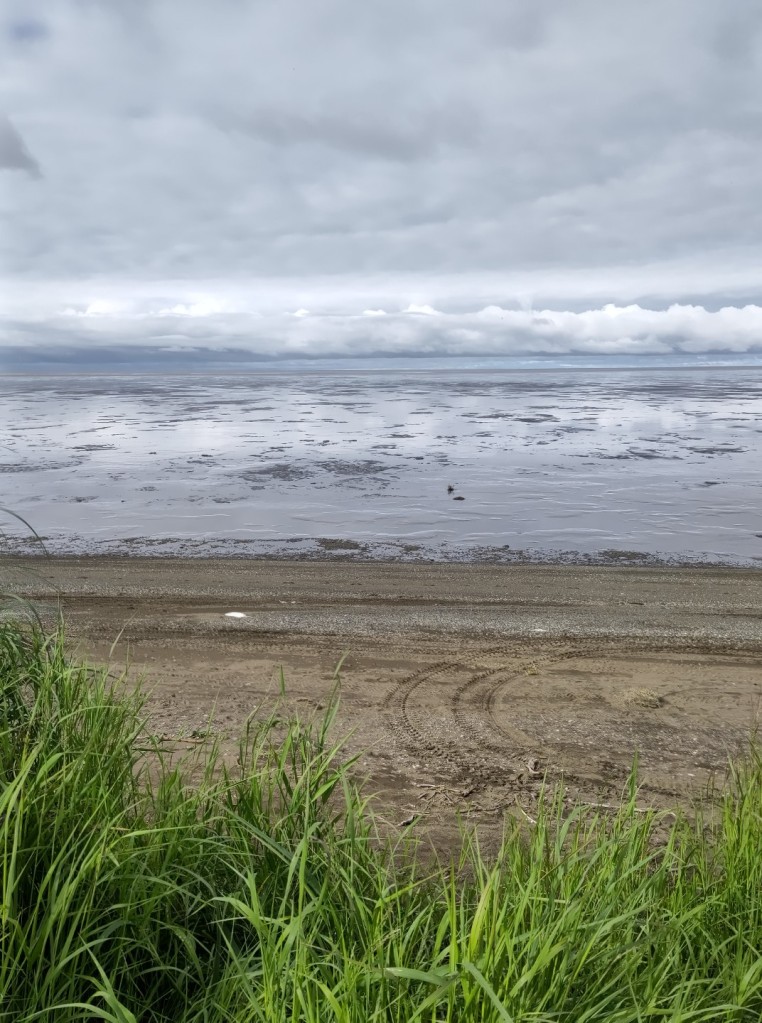
During the first week, we starting removing the grass and sod. It was tough, but it was not long before we started to see ash layers peeking from right under the sod. We were amazed to see the site beginning to reveal itself, and we were finding artefacts in abundance almost immediately. We regularly found incredibly preserved artefacts that on most other sites would be considered finds of the month: a slate blade, the first of many arrowheads, the first of many wooden dolls, several wooden and stone labrets, and the first strands of human hair. Towards the end of the week, Melissa and Mathilde found the first complete mask of the season. After uncovering the ash layer, the “drone guys” (Jonathan, Sean and Brian) took drone pictures for us. We enjoyed lunch-time power naps and food on the beach to escape the mosquitoes that swarm the dig site on days without wind.
At the end of the first week, we were joined by four conservators from the Anchorage Museum who helped take care of the artefacts we found in the excavation. The ambassador of France also paid us a visit. We enjoyed a traditional potluck meal with walrus soup, seaweed, herring and akutaq (the delicious local dessert), and we learned how to cut fish with an uluaq.


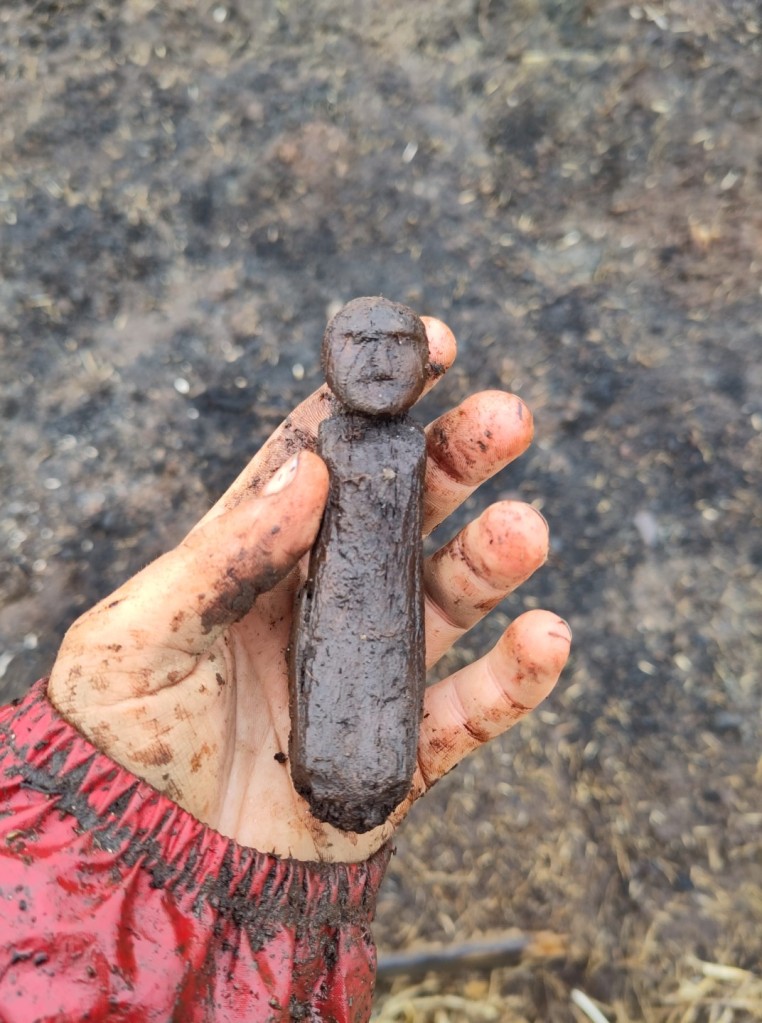
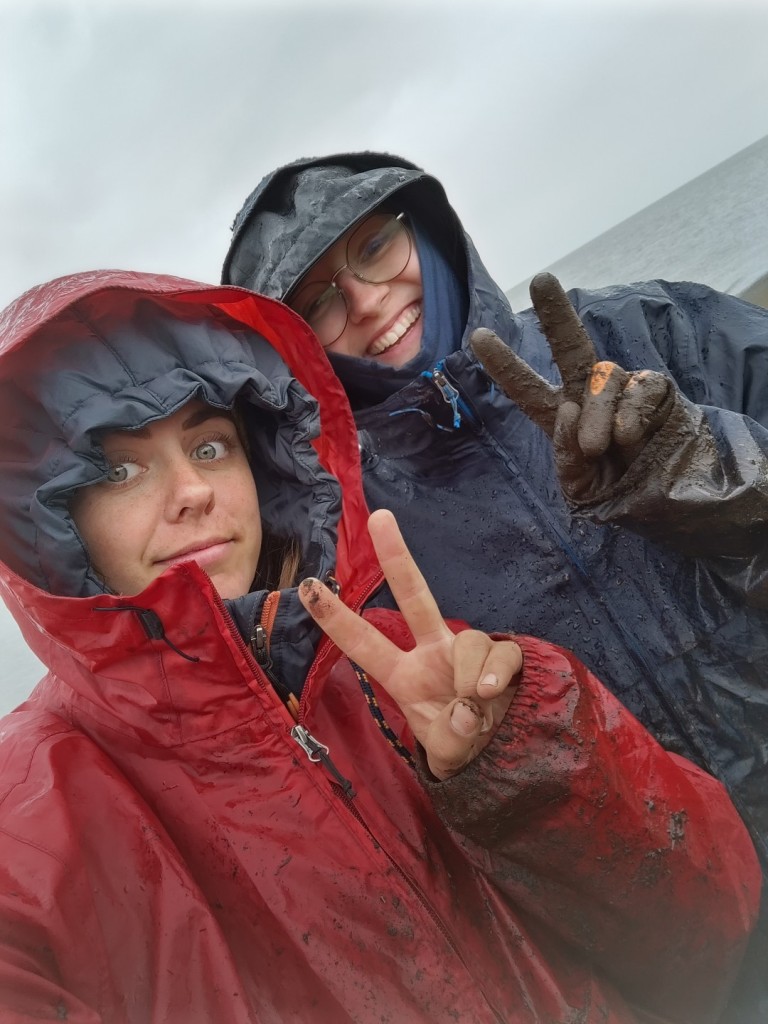
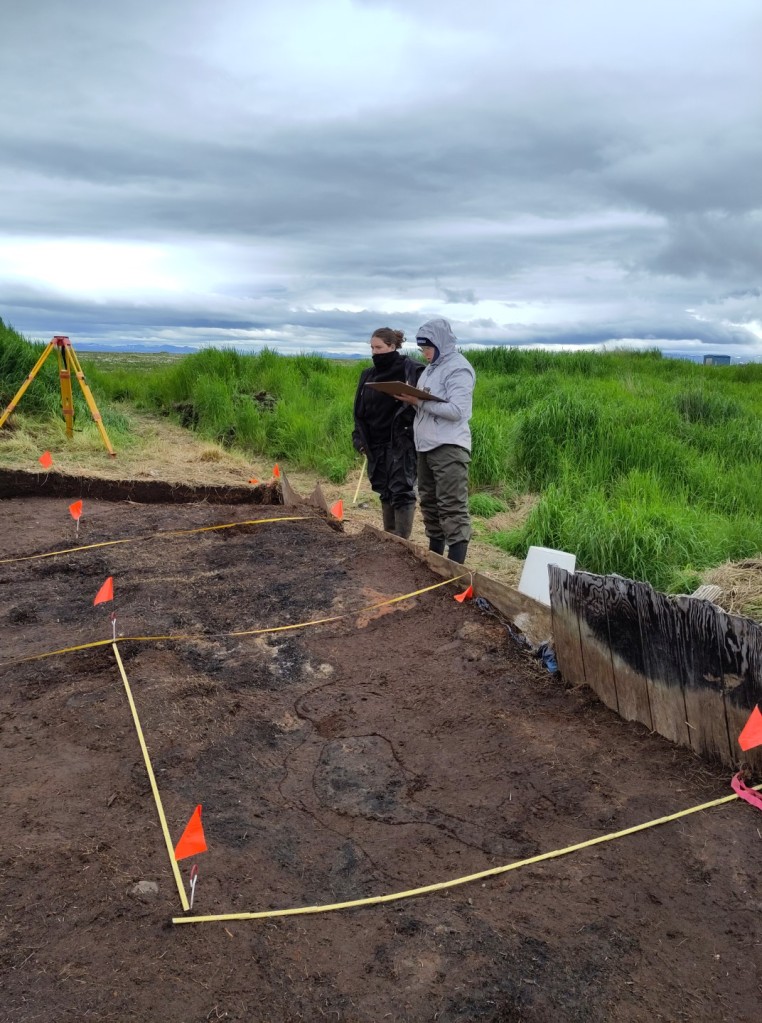



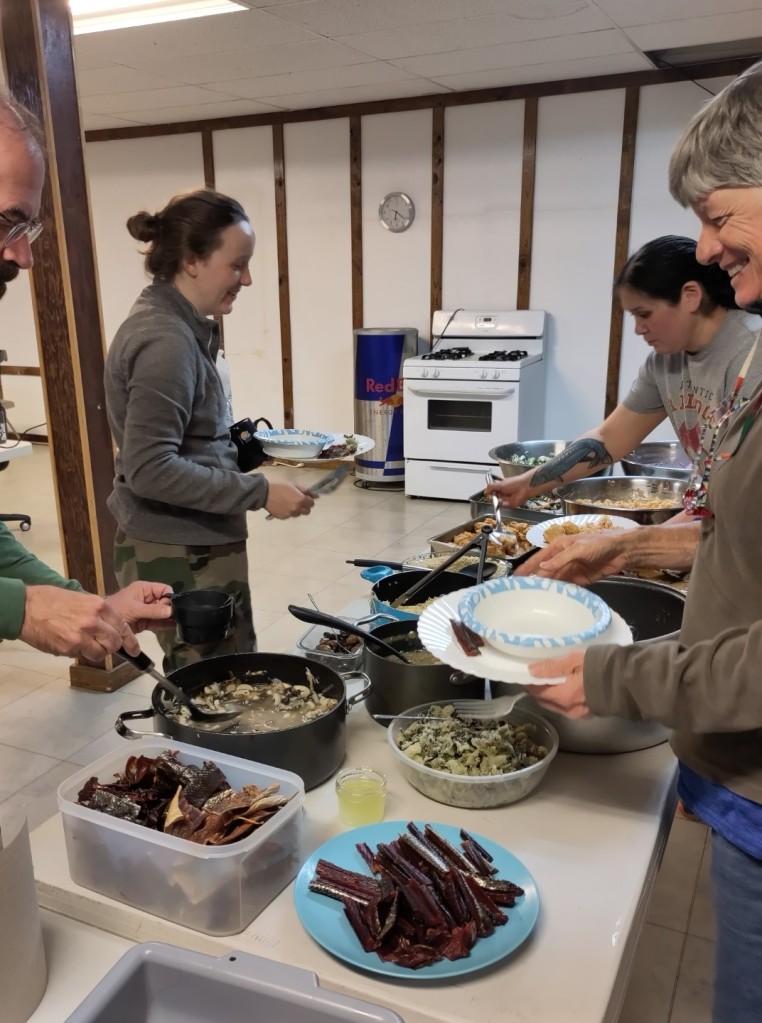
On the second week, the team grew to double the size, including several students and volunteers. We sketched the ash layer and found the first of many boardwalks. The artefacts kept popping up, including more wooden dolls, a seal uluaq handle, several bucket pieces, a wooden spoon, more labrets, the first leather piece, more human and dog hair, some half masks, and a stone axe.



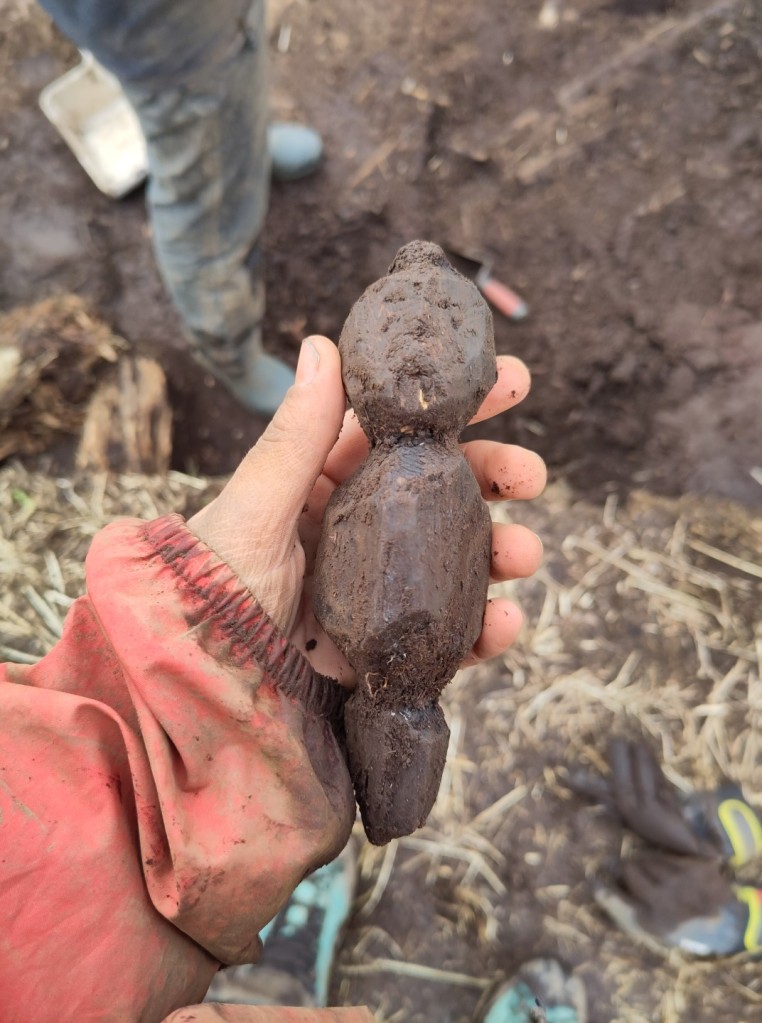
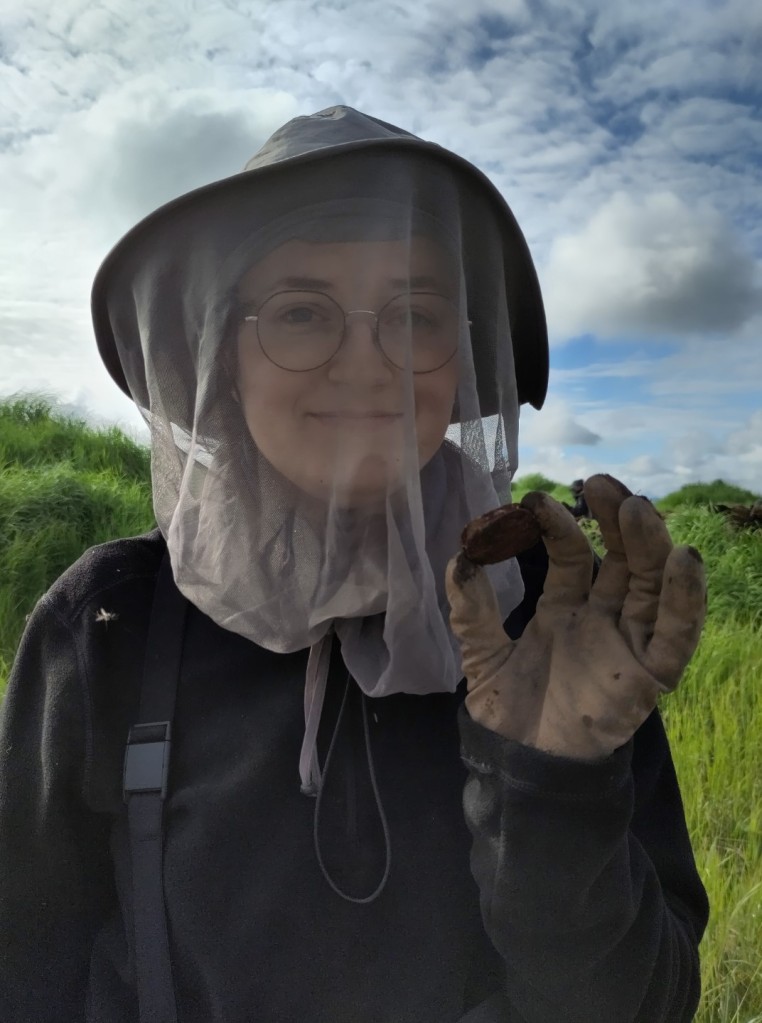




On the third week, we found bear tracks on the beach! We were amazed, though a little concerned. Rick started carrying a shotgun, for precaution, we never did see the bear. More boardwalks and floor layers came into view, and fish bones revealed themselves in abundance. We found kayak parts, basketry, leather, pieces of ivory, braided grass, a huge bottom of a bowl, a seal mask attachment, and carving tools. On Rick’s birthday, he found a complete ulu and Anna Mossolova found the second complete mask – both in the same day! We enjoyed several rides along the beach in the back of the truck or on the ATV. We were also joined by a French journalist and Canadian photographer who interviewed the villagers and took pictures at the site for the French magazine, Telerama.




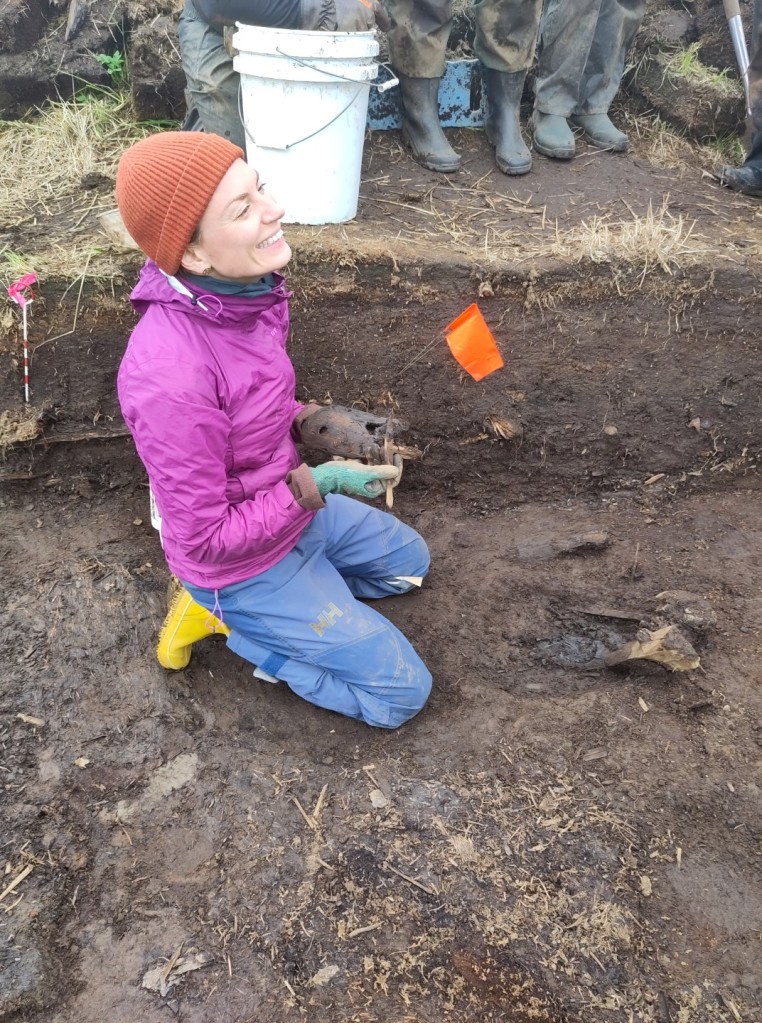


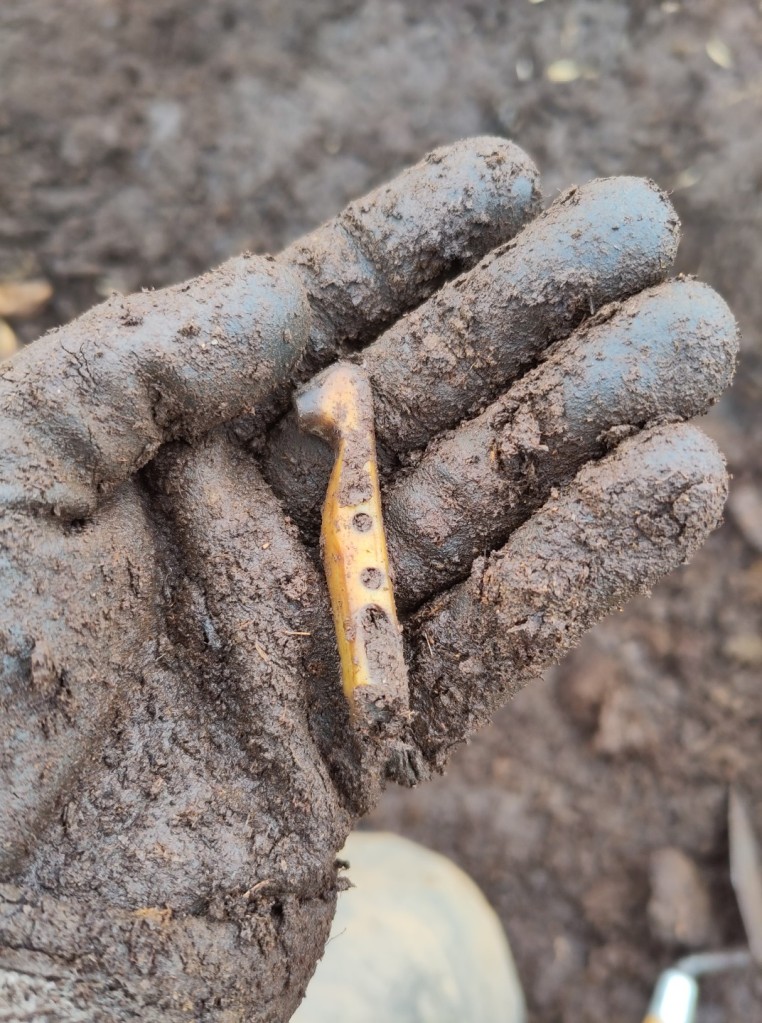

The fourth week started with wolf track sightings. We enjoyed several windy days that kept the mosquitos away, for once. We found several house floors, boardwalks and eight postholes, another seal mask attachment, an ivory spiral (perhaps an earring?), more labrets including one in precambrian marble, part of a leather shoe, lots of braided grass and more wooden dolls – including a pregnant one! It was a wet week, however, and the site got a bit slippery towards the end of it. After we woke up to a very rainy Friday, Rick made the call to spend a day back at the museum washing and cataloguing finds!









During our time off, we went fishing with local employee, Roy, in groups of 3-4. The fish were astonishing! Some of us were invited by his mom to try their traditional sauna, the maqii. Some of us tried our hand at bracelet making and, antler carving, one of us stayed up late several nights in a row to secure Taylor Swift tickets. We often went to get smoothies from the local store, walked around the village, and in the evenings we watched movies. We were often visited at the site and the museum by the elder John Smith, a noted ivory carver, who made jewellery for many of us. John grew up in a sodhouse not too different from the one we are excavating, and eagerly shared his memories with us, and with the researchers heading the project. He explained us how many of the finds were used, and told stories about everyday life in the men’s house.
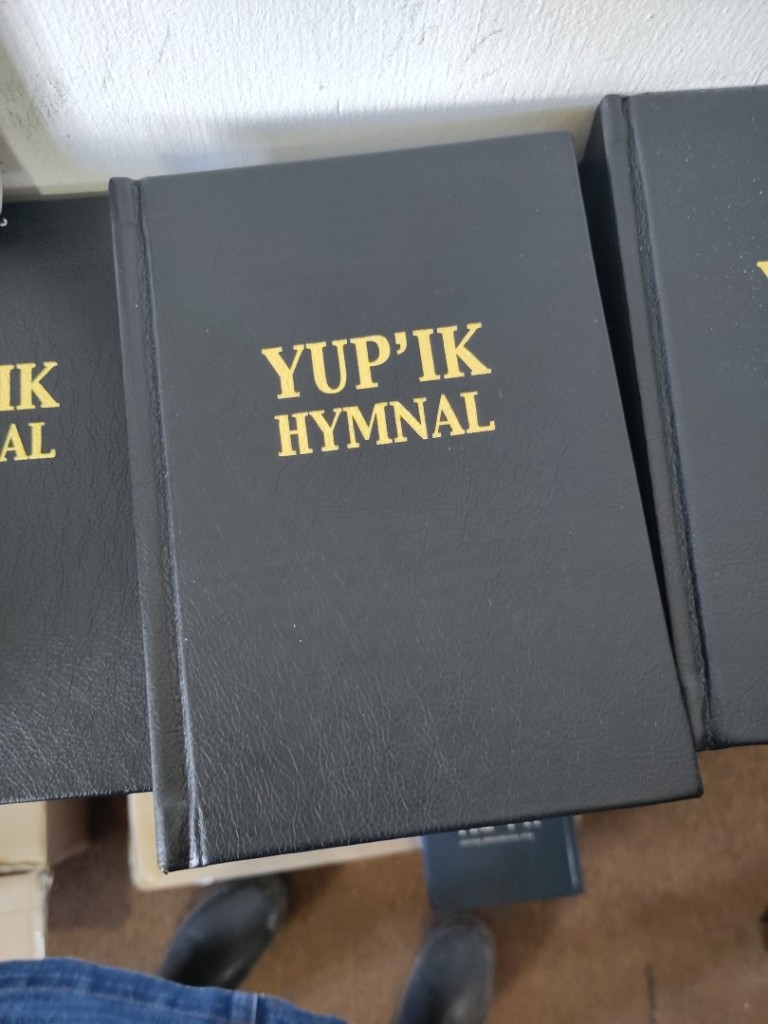

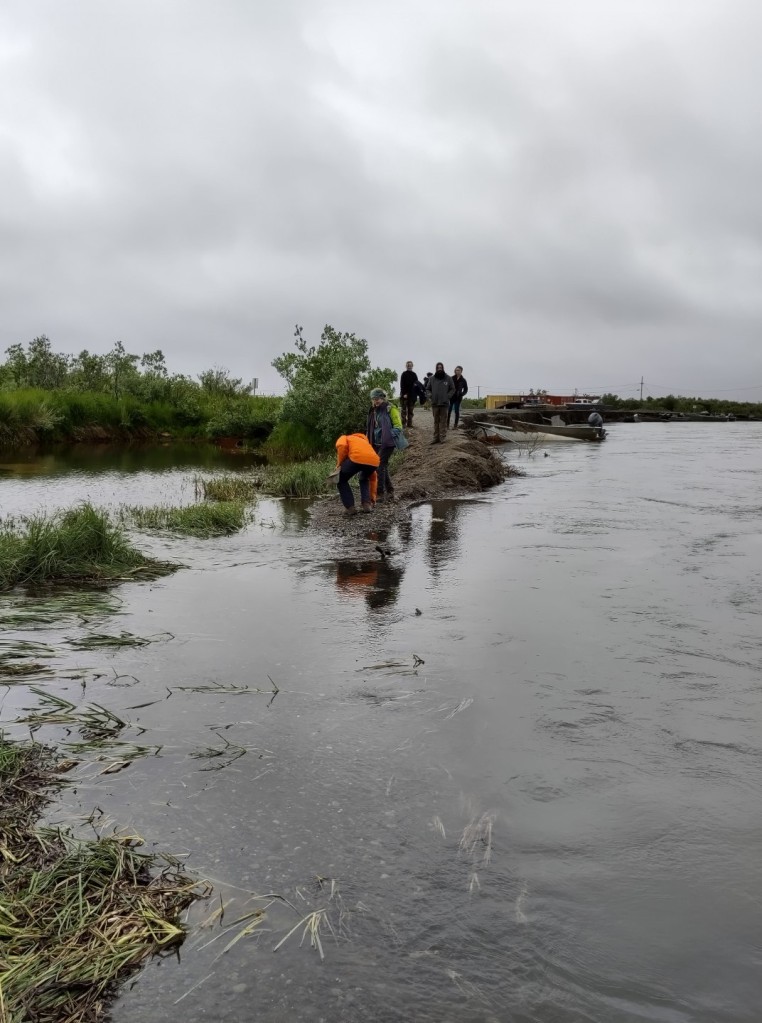
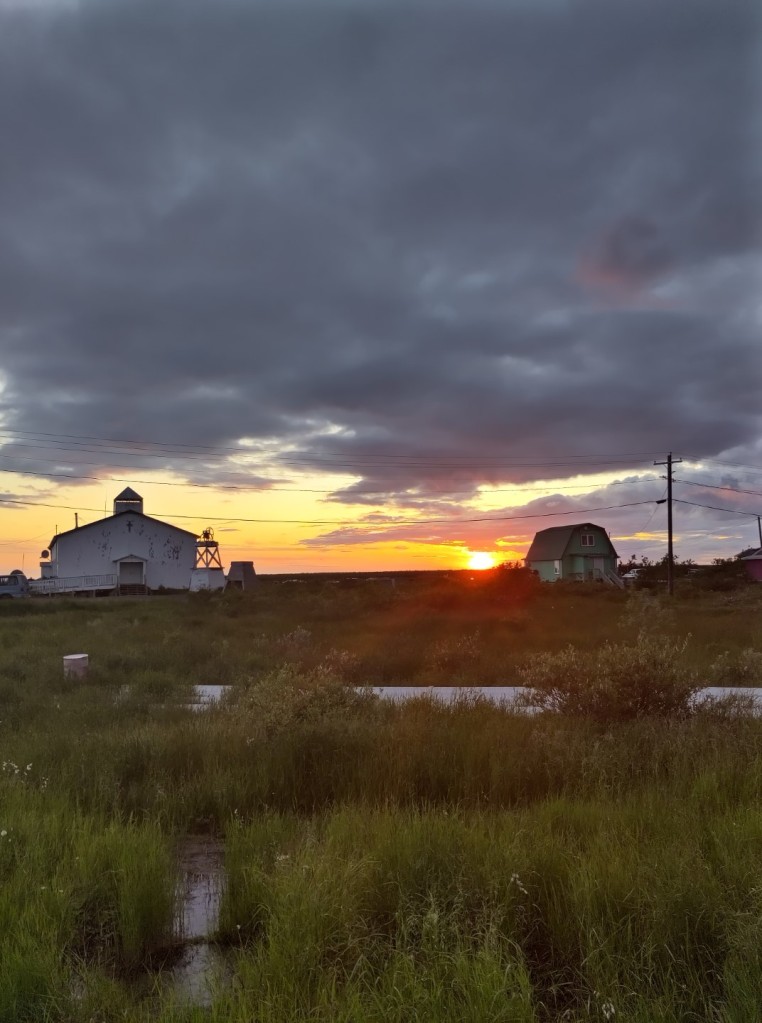
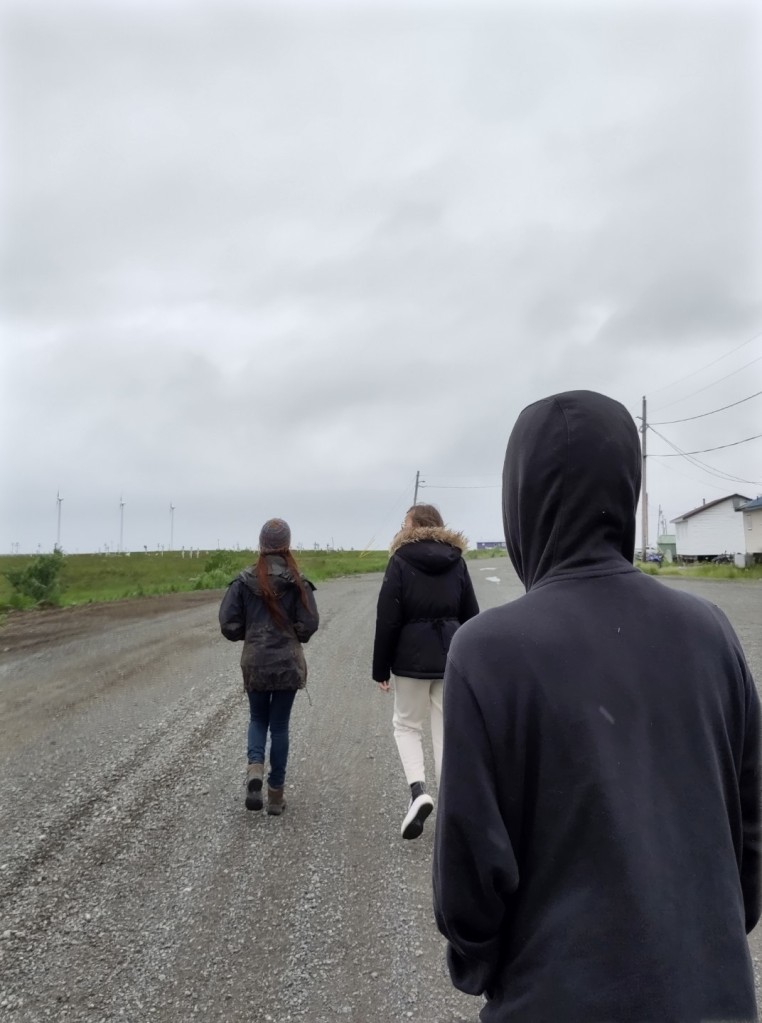
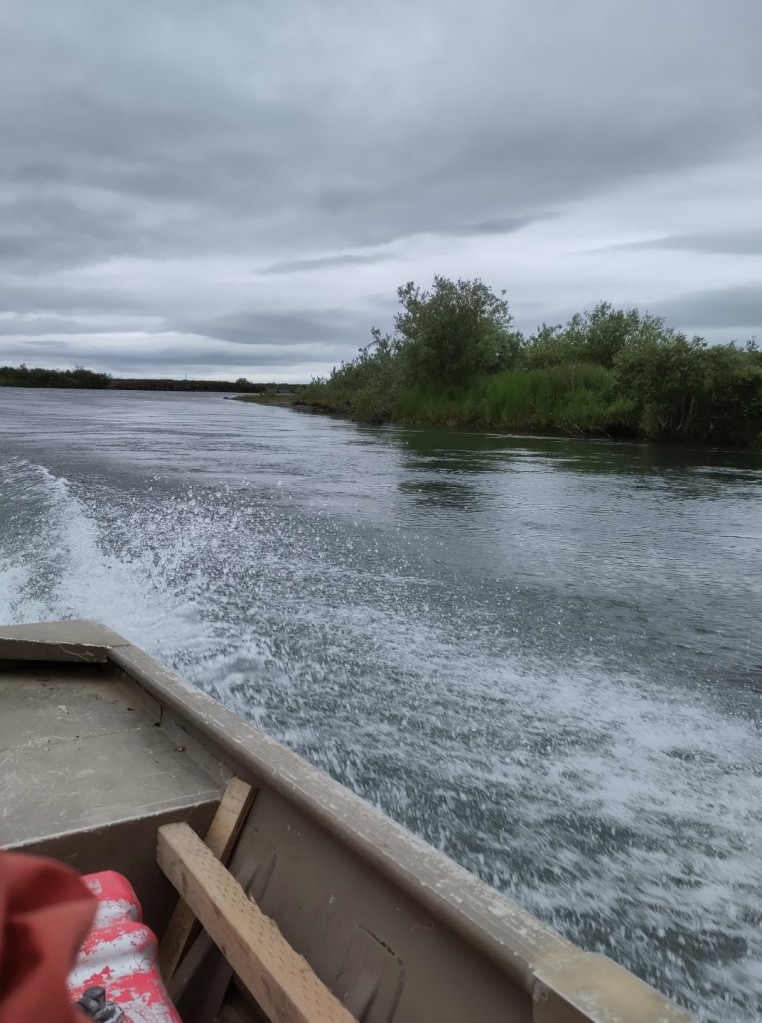
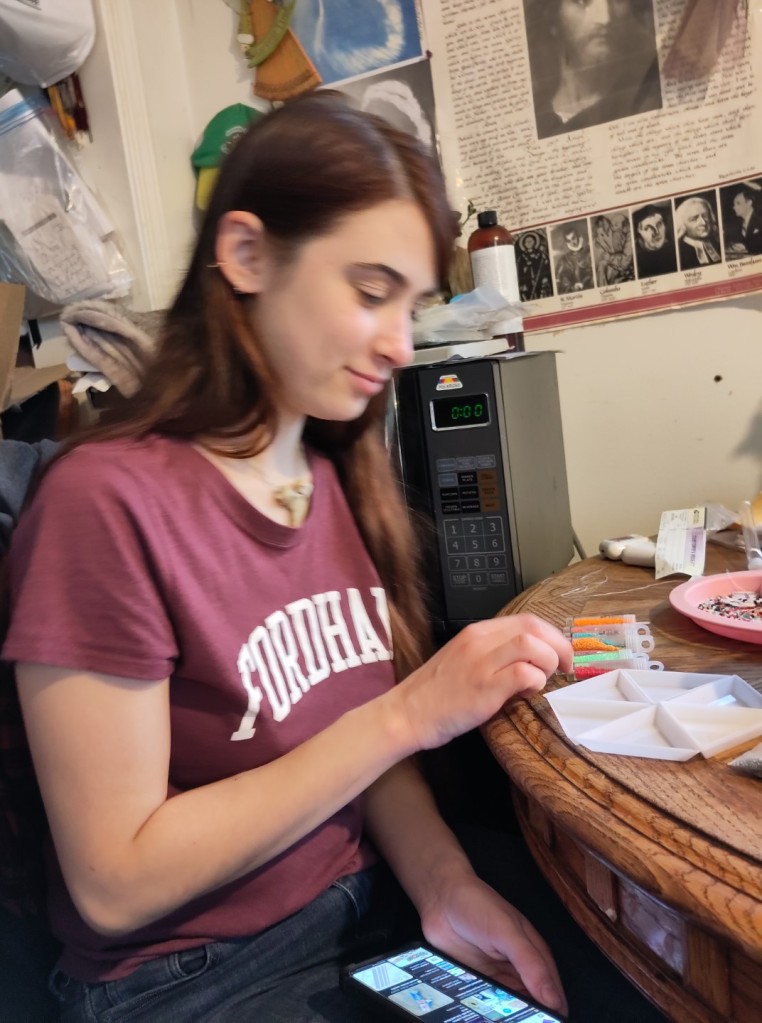


This post was written by Melissa Villumsen, Margot Martinet, Mathilde Girard and Nicolas Ravasi, all archaeology students.
Nunalleq Digital Museum & Catalogue Online!
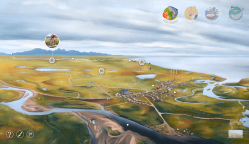
Not only are we busy kicking off the 2023 excavations at Nunalleq this week, but we are also delighted to share that the Nunalleq Digital Museum & Catalogue is now online! www.nunalleq.org/
This version works best for desktop – but stay tuned for a phone-friendly version coming later this summer ![]()
Using our new resource you can explore Yup’ik life in the past, told by the Quinhagak community in the present. Cycle through the seasons to unlock unique themed pages with artwork and media content based on current interpretations from over a decade of archaeological excavations at Nunalleq. You can also use the trowel icon to browse the catalogue of over 6000 objects from the collection.
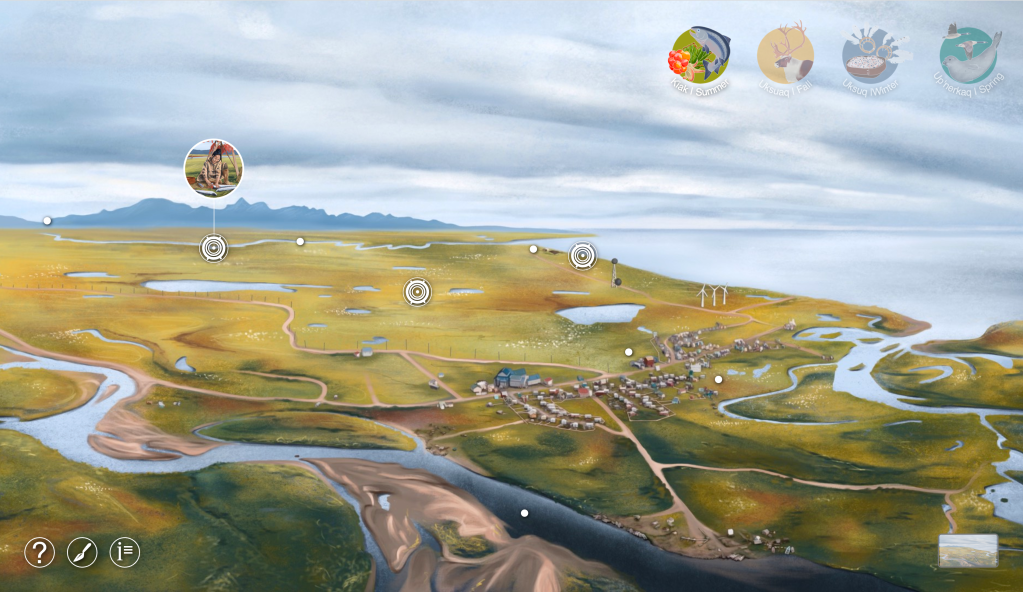


A sneak peek at some of the Digital Museum artwork
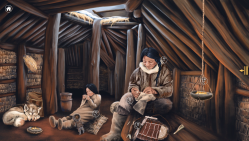
Last week we shared a 3D animated model of a mingqusviutat or needle case from Nunalleq, and the artwork below is a screenshot from our new resource where the needle case can be found. Our ‘virtual exhibition’ has hundreds of 3D scanned artefacts from the excavations which are hosted across 12 different themed pages – this page focusses on sewing in wintertime.
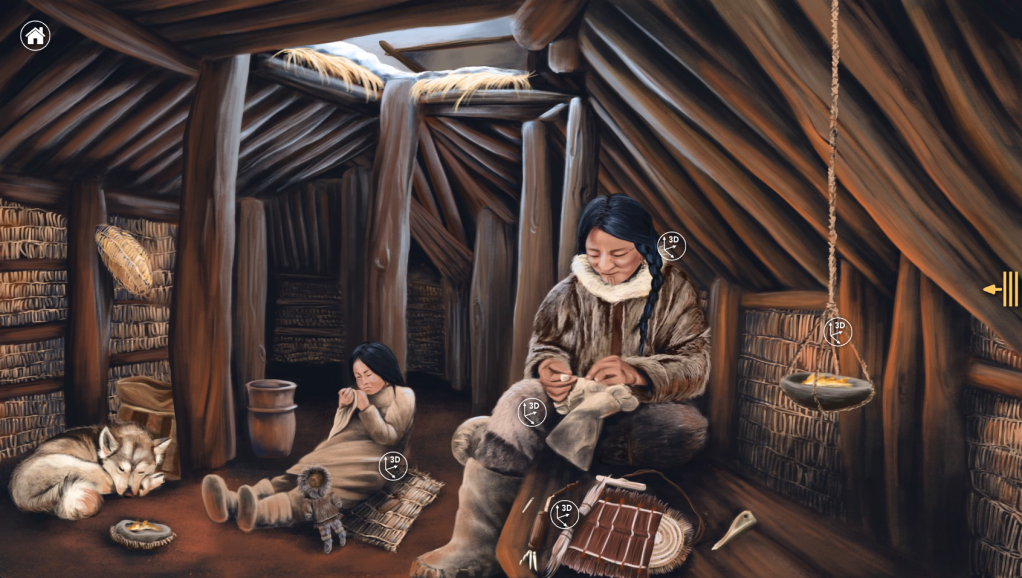
Animated Artifacts Coming Soon!

Next to share we have an animated reconstruction of a mingqusviutat or needle case from Nunalleq. Our new digital exhibition and catalogue (coming soon!) has a number of these animated models as well as over 500 3D scanned artifacts from the excavations.
